Lovely through the seasons, Deep Cut Gardens is ever changing. Its acres of gardens and greenhouses are a living catalog of cultivated and native plant materials. From the first buds of spring to the unexpected bursts of color in winter, Deep Cut Gardens never fails to delight visitors. Here's a look at what's happening in the garden:
Stunning Amaryllis Blooms
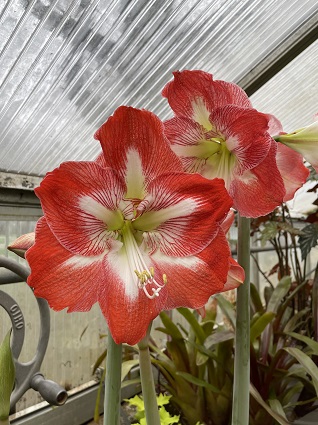
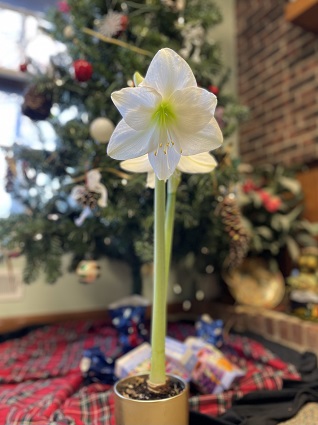
These easy-to-grow bulbs bring cheer and awe to any holiday party. For those who long for spring flowers, they offer the satisfaction of growing and blooming indoors. Their large vibrant flowers have the power to instantly brighten a gloomy winter day.
When cared for properly, an amaryllis bulb thrives for years. The secret for keeping it healthy involves excellent post-bloom care:
- After the bulb has flowered cut the stem about an inch above the bulb.
- Continue to care for the green leaves as you would a house plant, placing the pot in bright light and keep with the watering and feeding schedule throughout the spring and summer. (If possible, you could take the plant outside during the summer).
Late summer/early fall:
- Stop watering and fertilizing. Move the potted bulbs to your garage or basement in a cool and dry corner. The plant will go dormant.
- As the leaves wither and die, snip them off from the bulb. Let the bulb rest inside the pot for about 8 to 10 weeks.
On November 1:
- Take the bulb out of the pot and examine its condition. If it’s soft or moldy – discard, otherwise replant the bulb in a fresh potting soil. Place the pot in a warm, sunny spot indoors.
- Water thoroughly and mark your calendar. A healthy bulb should bloom in 8 weeks.
- Wait to see active growth before you water again.
Your amaryllis flower will last just as long as a cut flower which may be a good idea if you have multiple flowering stalks that are getting in each other’s way or if your bulb is too top heavy. (posted 12/14/2023)
August Begins Bright And Bold
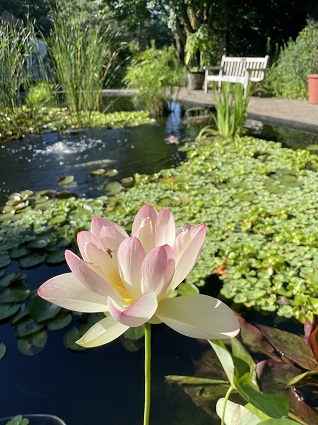
Lotus Flower
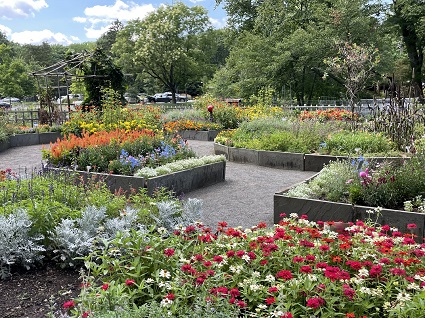
Display Garden
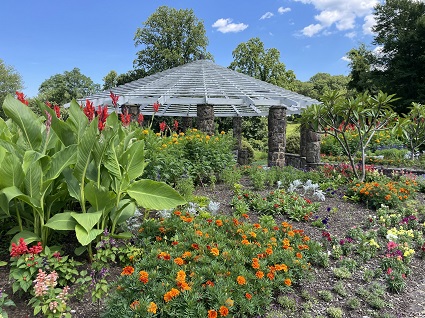
Pergola
It is the start of August and many of you have been calling wondering what is happening in the garden. There is construction going on at the Gardener’s Cottage, yet the garden grounds and facilities are open to explore. The All-America Display Garden is a true gem this year with bright and bold colors of zinnias, marigolds, ageratum and gomphrena. The rose parterre and pergola are boasting red canna lilies and two frangipani trees. The bonsai collection is out on display and the display green house is open for visitors. The front beds feature dahlias and a gladiola mix and there are water lilies and a lotus blooming inside the koi fish pond. (posted 8/2/2023)
Spring Is Here!
Spring has come in Deep Cut Gardens with the most mesmerizing colors. Bright yellow double-blooming daffodils welcome visitors from the moment they enter the property. Sweet heavy scent of viburnum fills the air while busy bees and bumble bees dart around the flowers. In the warm ground, the garter snakes are waking up and looking for a meal. The seeds we started weeks ago have grown into strong seedlings, eager to take root in the vegetable garden. Pinks and purples fill the horizon everywhere you look thanks to the million flowers on the redbud trees. The dogwoods and the azaleas are starting to open all along the garden paths. In the quiet of the evening, the frogs songs are traveling all the way into the rose garden mixing with the last calls of the song birds. (posted 4/21/2023)
Early Spring Beauties
This recent cold weather has not stopped our snowdrops as they are up and blooming. These early spring beauties are the flowers of hardy bulbs native to Europe and parts of Asia. They have colonized a small section on our shade trail, making them a great sight to see.
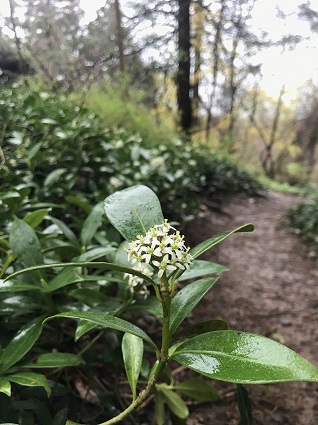
If you continue further on that same shade trail, your eye will be captured by the glossy green leaves and white flowers of the skimmia. Skimmia japonica ssp. Reevesiana could be seen blooming along the shade garden path behind the rockery. This evergreen ornamental is native to the Himalayas, China and Japan. In our care, the plant blooms during the winter months with fragrant white globular flowers that later set red berries resembling holly berries.
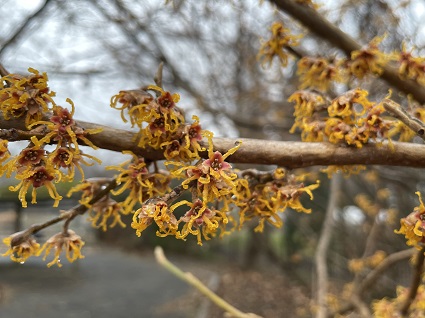
In a different section of our park, you can see our first blooming tree – the witch hazel. Witch hazel is a deciduous small tree native to temperate climates of eastern North America and Eastern Asia. Hammelis virginiana is currently blooming with golden-yellow flowers by the composting bins and the Children’s Garden. And if you happened to be strolling along the edges of our front lawn, you can see the lime-green flowers of the stinking hellebore.
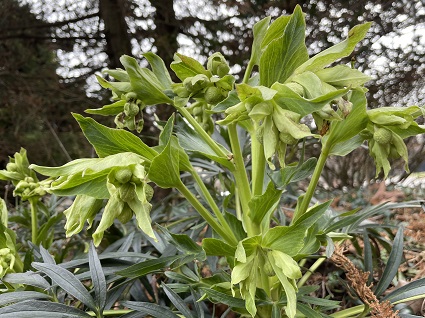
Hellebores bloom in the early spring. They are winter hardy with durable and cold-resistant flowers. They thrive in partially shaded, moist beds with good soil. This Stinking Hellebore, Helleborus foetidus, is currently blooming and can be seen in the far corner of our front lawn, tucked between the evergreens. Just like the other hellebores, it is native to the mountainous regions of Europe and Asia. (posted 2/8/2023)
Gold
September brings out the GOLD in the garden. Yellow is in fashion! From the wild senna and the golden rods in the fields to the gold finches, sunflowers and big duck yellow marigolds in the display garden! Tomatoes, squash, calendula, zinnia, corydalis, and orchids are all showing-off. What is your favorite?
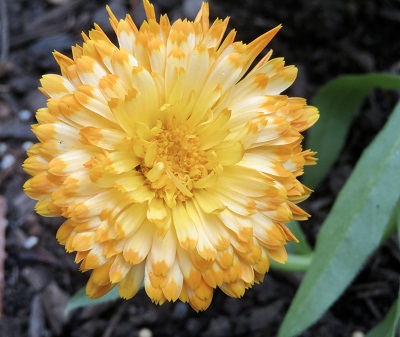
Calendula
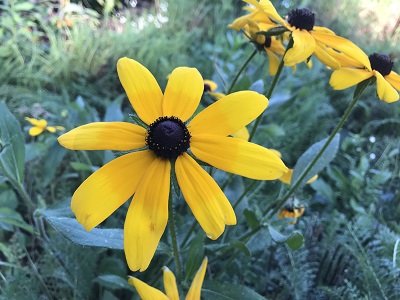
Black-eyed-Susan
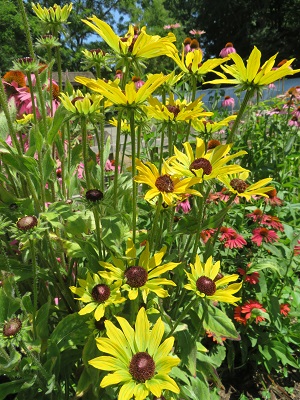
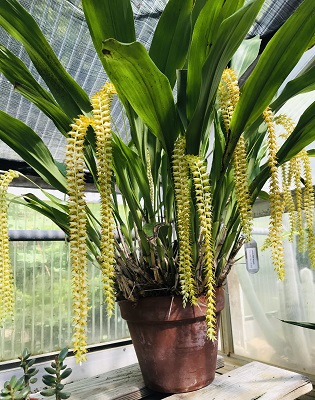
Cone Flowers Orchid Dendrochilum magnum
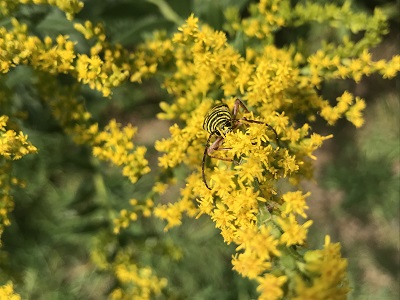
Goldenrod (posted 9/9/2022)
Hydrangeas
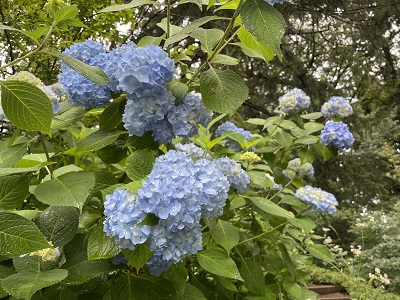
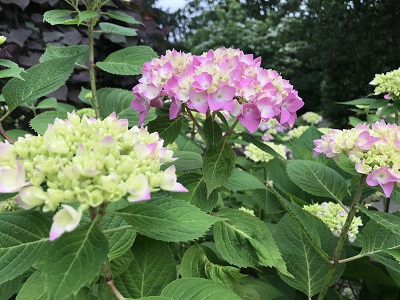
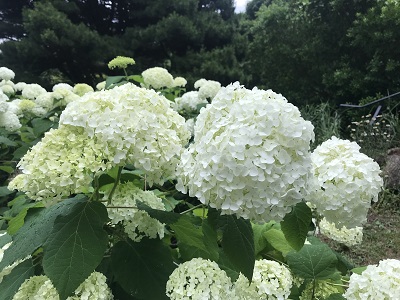
If you had visited us recently, you would have walked right by our newly planed “red, white and blue” flower beds proudly reflecting the colors of our nation’s flag. And if you attended a program in the Horticulture Center, you saw the awesome Hydrangea macrophylla framing the windy path. (posted 7/11/2022)
Chipmunk
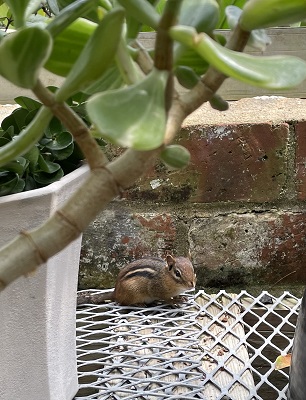
Chipmunk! Chipmunk here, chipmunk there, chipmunks everywhere! Is it just us or chipmunks are out in greater numbers this year? (posted 7/11/2022)
Sweet Bay Magnolia
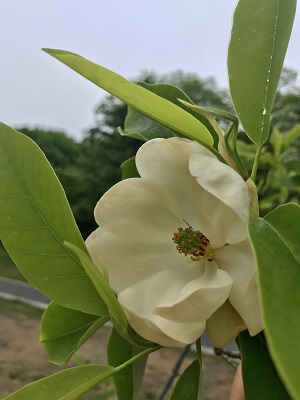
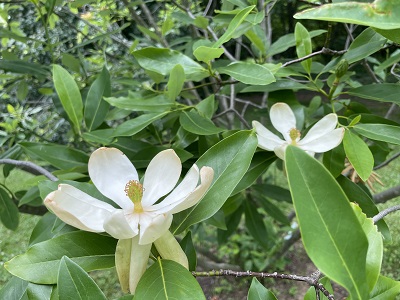
Heavy lemon-scented clouds hover over the garden path past the rose garden and the pergola. The native Sweet Bay Magnolia Magnolia virginiana is in bloom and its flowers attract pollinators and visitors alike. (posted 6/23/2022)
Eastern Tiger Swallowtail Butterfly
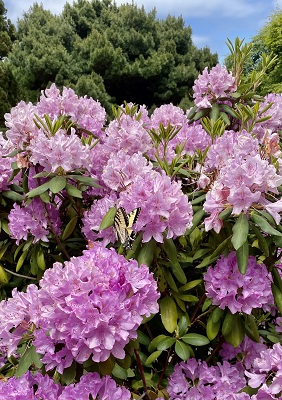
Garden greetings, today we spotted our first Eastern Tiger Swallowtail butterfly catching a meal at the rhododendron flowers. Have you seen butterflies in your garden yet? (posted 5/27/2022)
Japanese Maples
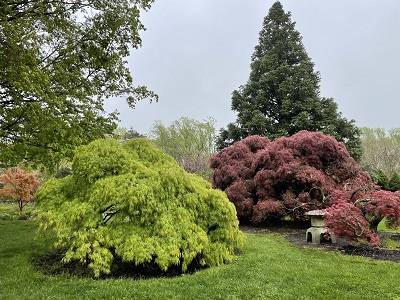
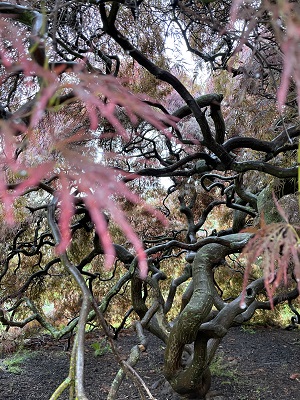
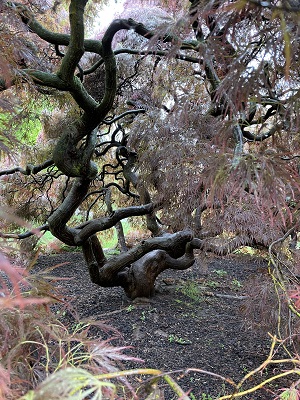
Our Japanese maples after yesterday's morning rain. We love their delicate and supple nature, their fine lacy leaves, their stunning colors, and their maze of gracefully bending branches. (posted 5/3/2022)
Tulips
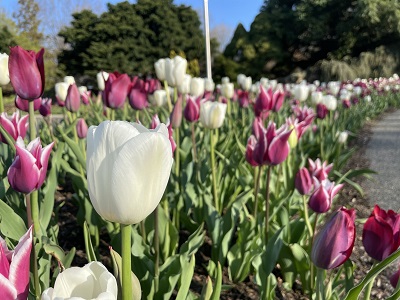

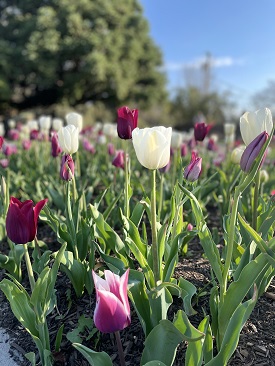
This year’s tulip display at Deep Cut Gardens is Calm Cool Collective! It consists of white, reddish purple and purple edged with white tulips. (posted 4/14/2022)
Hyacinths
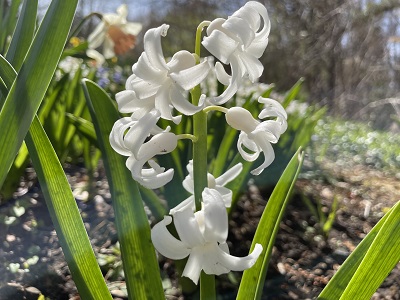
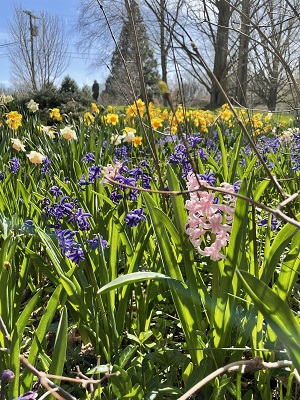
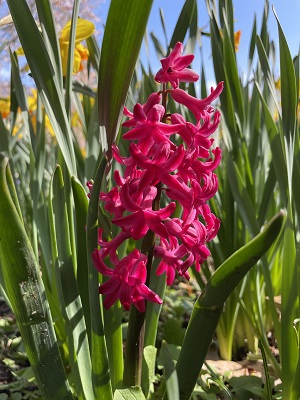
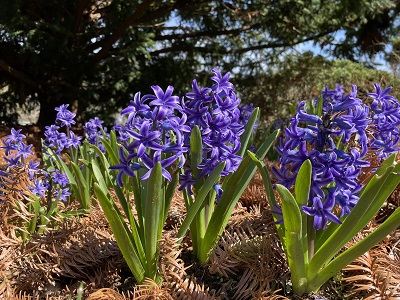
If you visit the garden these days, you'll undoubtedly notice the blooming Hyacinths. Their bright colors are a pleasant pop amongst the green and brown backdrop. Most of all, you'll notice the strong fragrance in the air surrounding the garden beds where the hyacinths bloom. Some say it reminds them of French perfume, others pick up a citrus smell. We love them all, and every year we keep planting more bulbs. (posted 4/12/2022)
Hellebores
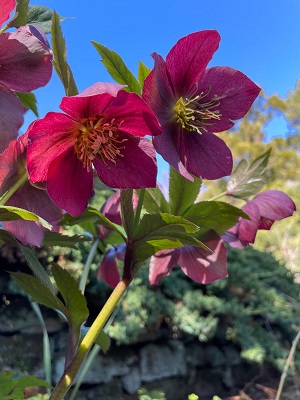
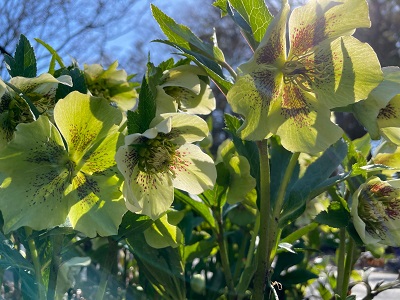
Recent drops in temperature and Sunday night's frost had indeed stunned some of the spring flowers, but not the hellebores. These amazing evergreen perennials are cold hardy, and their blooms stay strong and beautiful even throughout the frosty nights. Hellebore, also knows as Lenten rose (Helleborus orientalis), begin to bloom in late winter and continue blooming throughout spring, often coinciding with the time of Lent. They are great for shade gardens and are not bothered by deer and rabbits. When established, they barely require any care. (posted 4/12/2022)
From the Garden with Love
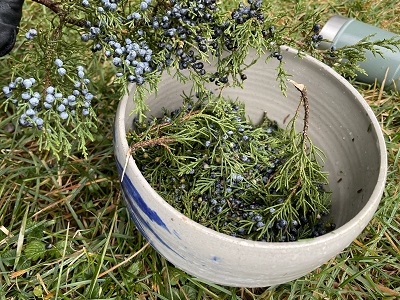
Eastern Red Cedar (Juniperus virginiana) commonly known as eastern red-cedar, red-cedar, eastern juniper, red juniper, pencil cedar, and aromatic cedar is the highlight of today’s garden story.
Many know of juniper mainly as the source of gin’s flavoring. Indeed, the name gin is derived from the Dutch jenever, which means “juniper”. But did you know the plant’s pungent aroma has deep roots in folklore, medicine, cooking and even spell casting?
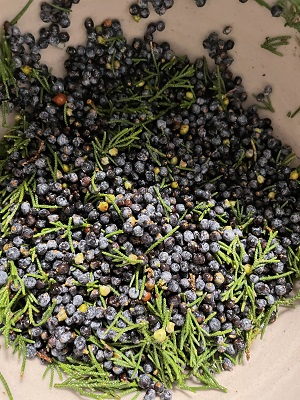
All parts of the plant contain volatile oil but it is most abundant in the plant’s ripe, freshly picked berries (which take two years to mature.) Have you ever tried a Juniper berry? They have a peppery, tangy taste and are often used in meat dishes and marinades. Juniper berry connoisseurs add them to sauerkraut, pates, salads and hors d’oeuvres.
Not all cedar trees have berries. Only female trees are loaded with “berries” (technically cones with fleshy scales), which develop from a pale-frosted blue-green to steel blue, to bluish black. These berries are source of food for many overwintering birds and mammals.
Medicinally, juniper has long been regarded as a diuretic and as a carminative (relieving intestinal gas) resource. It is still used for these purposes today. Traditionally, it’s believed that tea of juniper cured stomach aches and colds. Hot packs of boiled twigs and berries were once applied on sores to prevent infections due to the plant's antiseptic properties. During the 17th century, Europeans and Americans alike used it as a remedy for scurvy, worms, and dropsy; and as an aid in childbirth.
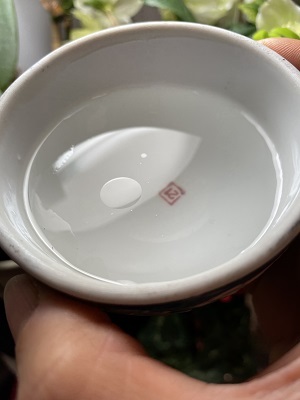
Today, we picked juniper berries from one of our trees here at Deep Cut Gardens and, with a little luck, we will harness their healing powers for everyone to enjoy.
We are making a hydrosol (a hydrosol is a water-soluble extraction of distilled plant material) using an Alembic still. First, the berries get a quick rinse and after sorting them, they are loaded into the still. We add fresh water and turn up the heat.
The process of distillation captures the essential oils and mixes them with the condensate vapors. The product is clear hydrosol aka essential water.
After 30 minutes, we have enough product to fill up a small bottle. Essential waters are safe to use. Their water-soluble compounds contain small amounts of essential oil, making them a popular choice and a better alternative to oils and tinctures. They are used internally, externally, in cooking, as a toner, in creams, as aromatherapy, and for cleaning. A juniper berry hydrosol is perfect for fighting “cabin fever” and aids in clearing the mind. It's certainly not as ideal as getting out amongst the trees, but it can serve as a wonderful experience.
Bark Talk
A garden walk during the winter months always includes the highlights of hollies and their bright red berries, a number of bird’s nests tucked away in the rose bushes, and - most of all - the amazing colors, shapes and textures of the different tree bark around. We get a lot of questions about tree bark and in particular tree bark that is peeling off from the tree trunks. Some visitors find that fascinating, others - alarming.
The process of shedding bark, or exfoliating, is normal for some trees. Weather influences this process, including how much of bark is shed in a season. Shedding or peeling bark is characteristic of trees such as the sycamore, redbud, silver maple, shagbark hickory, birch, and Scotch pine. For example, the grayish brown bark on a large sycamore tree flakes off in irregular blotches revealing a cream or whitish gray inner bark.
As the tree grows, the bark hardens and with time matures. When the new bark is ready to take over, the old one falls off. One example that can make this process easier to relate to is our own skin. When the skin on our heels is mature and hard, it is exfoliated to give way to the new flexible and better functional skin layer underneath.
And here comes the drum roll: Bark shedding is an evolutionary trait that some trees have adopted because in addition to their leaves, trees can photosynthesize throughout their bark which often gets obstructed when covered with moss, lichen and dirt. The trees simply peel it off and start anew.
Exfoliating bark trees provide a great home for bats. These little creatures often seek a fold to roost and stay protected. Other peeling bark tenants are caterpillars seeking for a place to set up their cocoons for the season.
If you are looking to add a wintery bark interest to your garden, here is a list of trees that may help you find the one you like most:
Bald Cypress (Taxodium distichum), Birch (Betula spp.), Black cherry (Prunus serotina), Crapemyrtle (Lagerstroemia indica) pictured, Dawn redwood (Metasequoia glyplostroboides), Eastern red cedar (Juniperus virginiana), Ironwood/hophornbeam (Ostrya virginiana), Lacebark elm (Ulmus parvifolia), Paperbark maple (Acer griseum) pictured, Redbud (Cercis canadensis) pictured, Scotch pine (Pinus sylvestris), Shagbark hickory (Carya ovata), Sycamore (Platanus occidentalis) and Zelkova (Zelkova serrata).
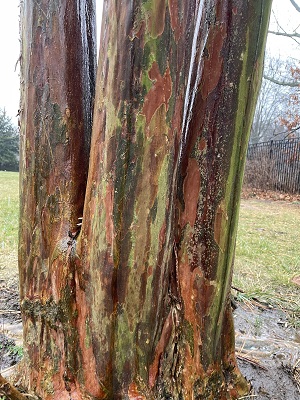
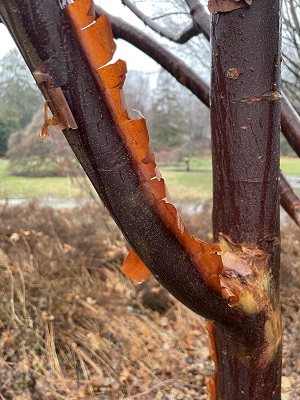
(pictured l to r - Crapemyrtle & Paperbark maple)
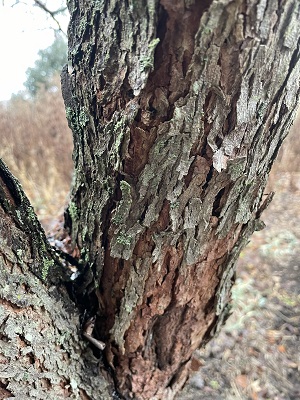
Pictured - Redbud
Sometimes peeling tree bark could look like it’s happening naturally when in reality it is caused by damage. Both of these examples came from our park: the first one is due to deer damage. Bucks often look for trees to rub and mark with their scent and in the process strip the bark off the tree. The second example needs no explanation. Please just do not do it. We all embrace human emotions as we too feel them the same. If you want to memorialize your new love, why not plant a tree in his or her name instead? That way everybody wins!
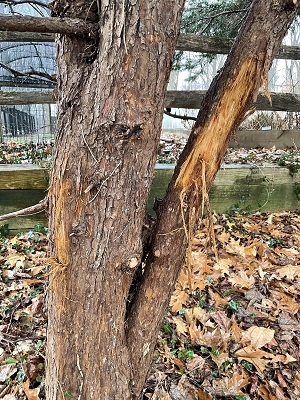
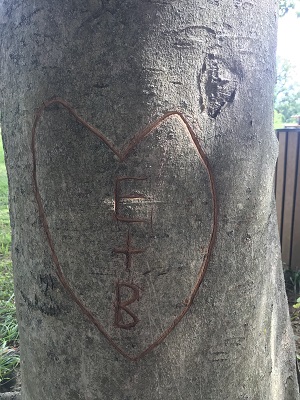
The Fall Season
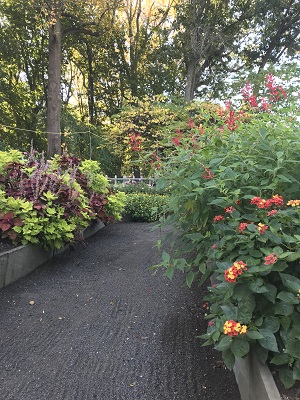
The fall season adores the garden in with purple, yellow and red hues from the ground all the way up into the tops of the trees. Walking about visitors can encounter chipmunks and groundhogs rushing to collect fallen nuts and berries. Finches and sparrows picking the leaf piles while the jays and robins out sing each other. The garden beams full with red pineapple sage blooms and cheery chrysanthemums. The cold-loving clematis in the display garden is having a second blooming season and the lovely camellia greets every visitor walking by with stunning pink flowers. There are endless possibilities of encountering beauty and serenity here at Deep Cut Gardens.
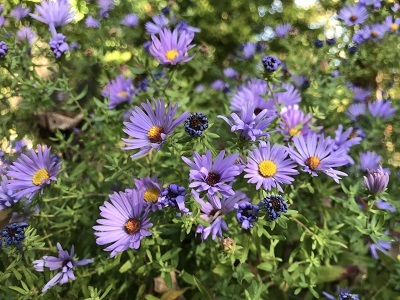
New England Aster
New England Aster – native perennial perfect for late season color; blooms are rich, deep violet to lavender-pink.
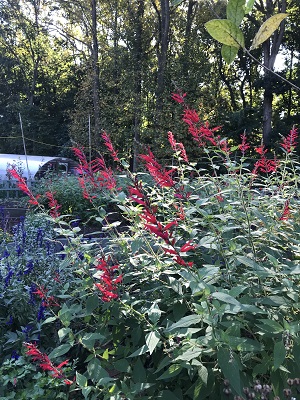
Pineapple Sage
Pineapple Sage (Salvia elegans) - a tender perennial best grown as annuals in our region. It is not recommended to grow them from seed unless started indoors and set out as well developed plants.
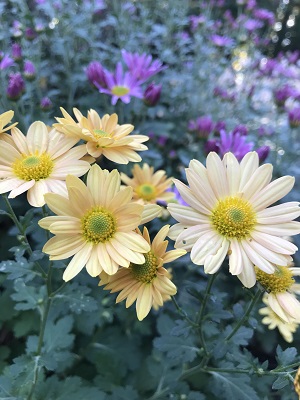 Hardy Chrysanthemum
Hardy ChrysanthemumHardy Chrysanthemum (Chrysanthemum 'Hillside Sheffield Pink') - This is a hardy, perennial mum that blooms in the fall with single, daisy-form flowers. The buds and newly opened flowers are a lovely shade of apricot pink. As the flowers age, they lighten and become a warm cream color. It spreads easily, so give it some room. It is easy to grow from cuttings or divisions. It is drought tolerant.
Camellia
Camellia – native to Japan, the camellia blooms from fall into winter, making it a perfect choice for winter gardens.
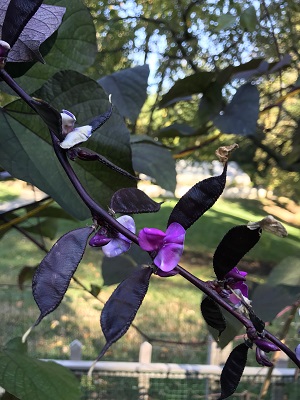
Purple Hyacinth Bean – this is a vigorous annual ornamental vine. The purple hyacinth bean plant (
Dolichos lablab or
Lablab purpurea), is easy to grow, blooms constantly and adds purple color to your landscape.
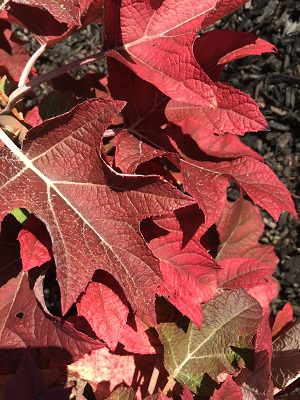
Oak Leaf Hydrangea
Oak Leaf Hydrangea – although the hydrangea is done blooming, its color contribution continues as the leaves turn red and purple.
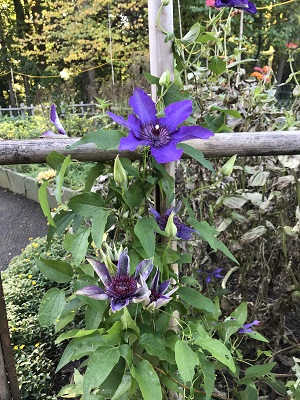
Clematis
Clematis – this cold loving vine blooms in the spring vastly covering the trellis. With the summer heat gone, the cold and sunny fall days wakeup the clematis into another blooming show before the frost.
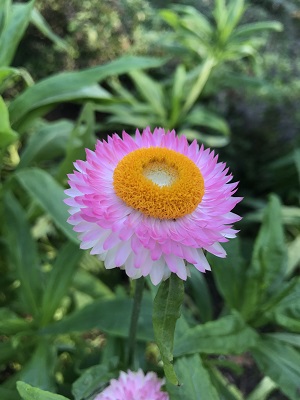
StrawflowerStrawflower – we love strawflowers as they are all amazingly pretty even after they are dry. Did you know that strawflowers are deer resistant?
(posted 10/22/2021)
The Display Garden is In Full Bloom
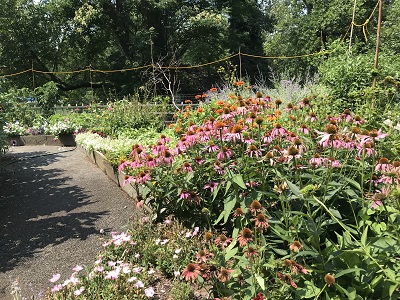
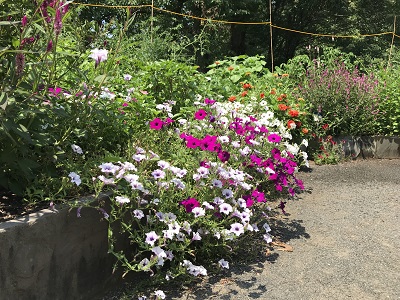
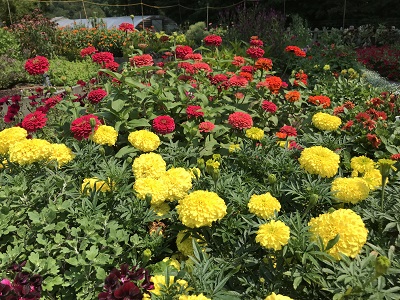
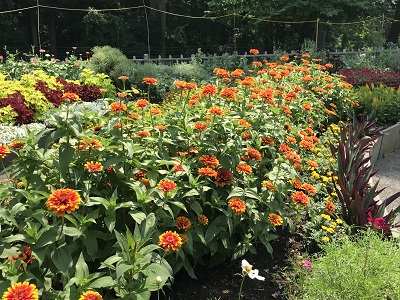
(posted 7/28/2021)
Pelargonium
Commonly called “geraniums,” these beautiful long blooming plants adoring window boxes, containers, and display gardens are actually Pelargonium. While geraniums and pelargoniums are related as members of the Geraniaceae family, there are distinct differences between the two in growth, appearance, and seed dispersal technique. Pictured here are examples of Pelargoniums currently blooming in the All-America Selection Display Garden.
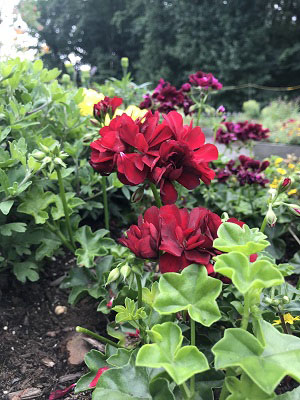
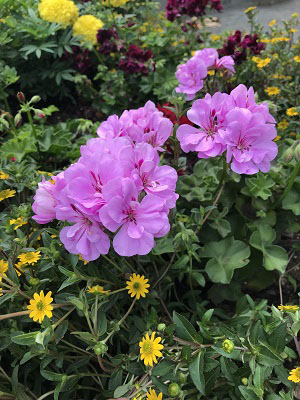
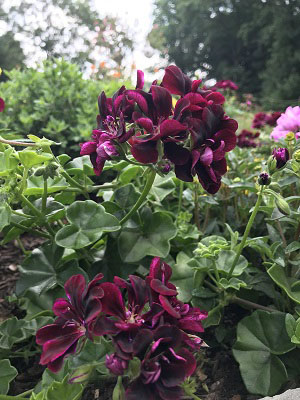
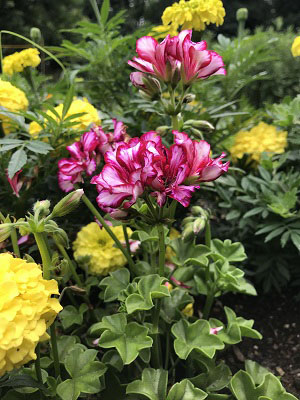
(posted 7/12/2021)
Rose Campion
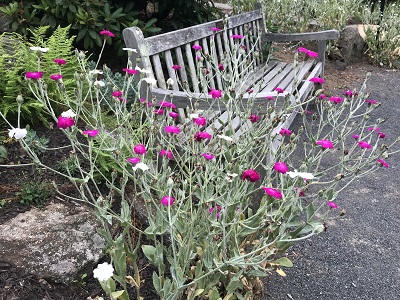
Rose campion (Lychnis coronaria) is an old-fashioned favorite that adds brilliant color to the flower garden along the koi fish pond and in the beds of our rockery. The beautiful blooms are in shades of magenta, bright pink and white.
Astilbe
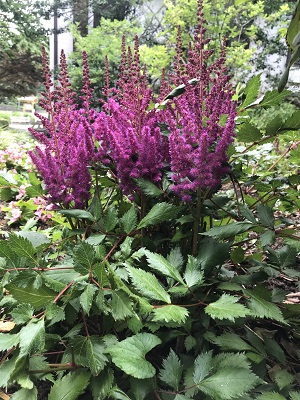
Astilbe is a perennial with beautiful, showy flowers atop glossy, fern-like foliage. This ornamental plant is a great addition to a shade garden and could be paired with hostas. They both like consistently moist soil.
Catmint
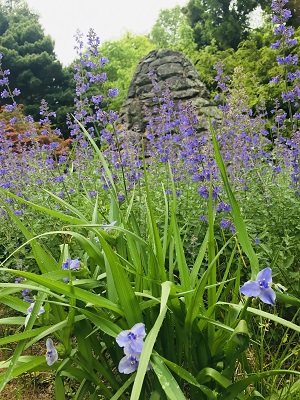
Catmint (Nepeta) currently blooming in our herb garden and around Mt. Vesuvius. It is a perennial herb that is a member of the mint family. It is an extremely easy growing plant with few pests or problems. A must for a pollinator garden- its flowers are abundant all summer long and they can be white, pink or lavender blue.
Chamomile
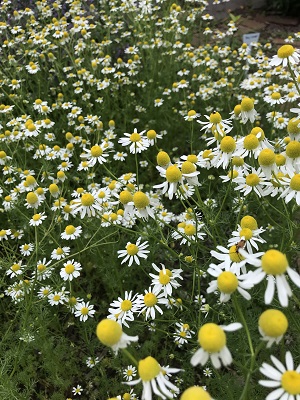
Chamomile (Chamaemelum) can be found blooming in our herb garden, most likely completely covered with bees. The flowers attract beneficial insects including helpful flies, wasps, beetles and bees, and are used as a companion plants for our vegetables.
Yarrow
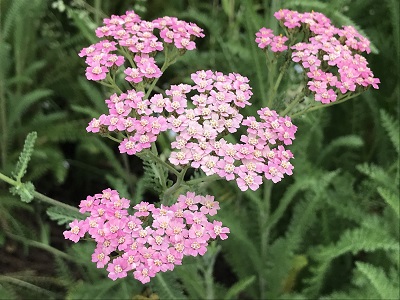
Yarrow (Achillea millefolium) is a native North American plant that’s a favorite stop for pollinators and is practically care-free. You can see it blooming in our deer resistant garden and as a border of our vegetable garden.
Lamb’s Ears
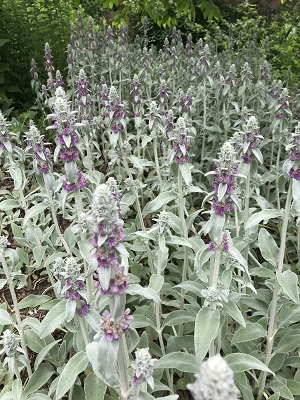
Lamb’s ears (Stachys) The blooms of this amazing perennial welcome visitors along the path’s entrance. The blooms are blue to purple in color and attract pollinators galore. You will recognize this plant by its fuzzy texture and silver colored leaves. Lamb’s ear in native to Turkey and Iran, yet it grows very well in New Jersey.
Lavender
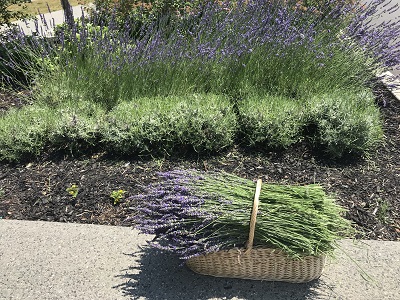
Lavender (Lavendula) is native to the Old World and the Mediterranean lavender has earned a significant place in our landscape. We love the way it frames the flower beds by our parking lot where it gets full sun and a lot of visitor attention.
Yucca
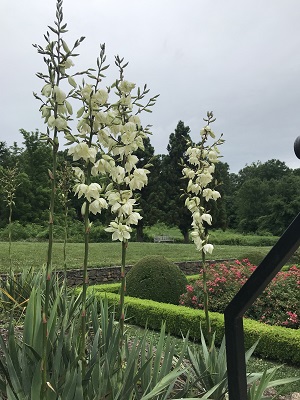
Yucca (Yucca glauca) – Towering over the entrance to the Rose garden are the tall blooming yuccas. Native to South America and the Caribbean, these drought and heat tolerant plants amaze our visitors with their interesting flowers. Did you know that they are pollinated by the yucca moths?
Hydrangea spp.
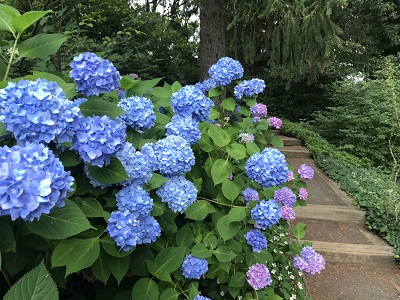
Hydrangea spp. – Nothing says summertime more than the iconic Hydrangea blooms! Blue, pink, white, cream and purple; tall, short, climbing or variegated – we have them in abundance and still want more.
Coral Reef-Mimicking Display
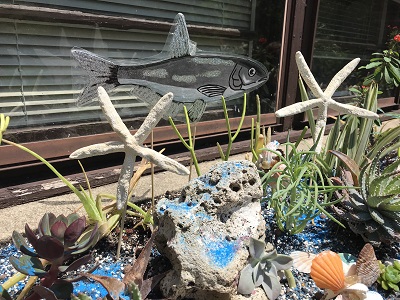
This Coral reef-mimicking display welcomes visitors to the Horticultural Center. This original mixture of succulents, sand, rocks and seashells is our way to raise awareness about the coral reefs on our precious planet. We recognize that while they are different ecosystems, coral reefs and gardens alike need protection, care and preservation. (posted 6/24/2021)
Herbaceous Peonies
It is peak peony season in the garden! It is hard to miss the herbaceous peonies in our front lawn and around the koi fish pond. Did you know they symbolize happiness, prosperity and happy marriage?
Wild Hyacinth
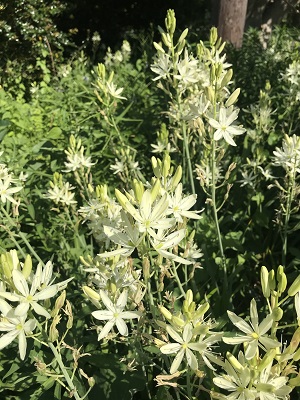
Wild Hyacinth (Camassia scilloides) is a native perennial currently blooming by the koi fish pond. Historically wild hyacinth bulbs were used for food by Native American people as the bulb can be substituted for potatoes. Yet, not all varieties of wild hyacinth are edible and some are quite poisonous.
Eastern Bluestar
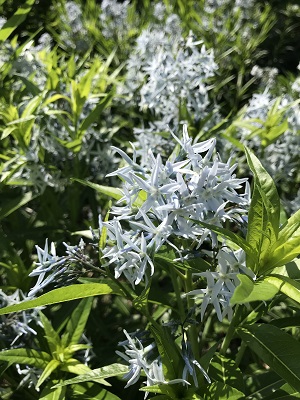
Eastern Bluestar (Amsonia tabernaemontana) is also a native perennial currently in bloom by the koi fish pond. We love the “clouds of blue” by these plants, yet most of all we love their extremely LOW maintenance.
Blue Wild Indigo
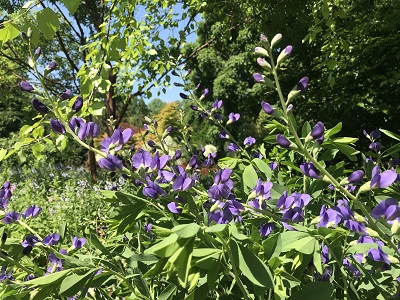
Blue Wild Indigo (Baptisia australis) This native perennial provides critical habitat for bumblebees and as a part of the pea family, it fixes nitrogen in the soil.
Ornamental Alliums
Ornamental Alliums are in full bloom! They are hardy, easy to grow and take minimal space, yet their blooms are exquisite and fun for everyone to enjoy.
Peonies
The peonies throughout the garden are in buds. We expect them to begin opening this weekend. (posted 5/21/2021)
Garden Update
This week the garden paths are adorned with bold and bright colors of azalea and rhododendrons - white, pink, purple, orange, yellow and magenta tones could be seen from afar. Lilacs and blooming Alliums are out. The hummingbirds are frantic amongst the columbine flowers by the koi fish pond. Dutchmen’s Pipe and Clematis are blooming their hearts out at the entrance of the All-America Selection Garden. Our Display Greenhouse is fragrant with the beautiful scent of Frangipani – currently in bloom inside the cactus room. Flowering Dogwoods and Fringe trees line up the quiet path to the pond. There are blooms and signs of life in every inch, bend, nock and cranny that you can witness.
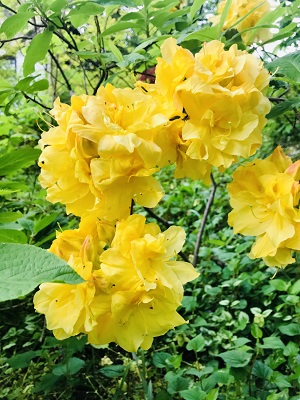
Azalea
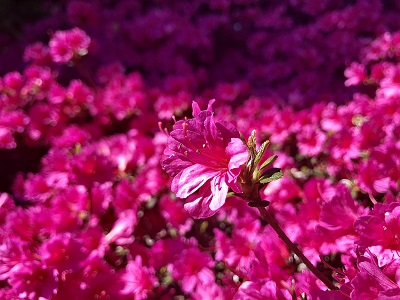
Azalea
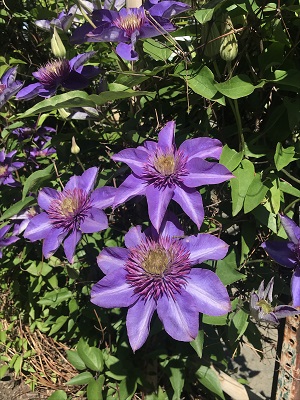
Clematis
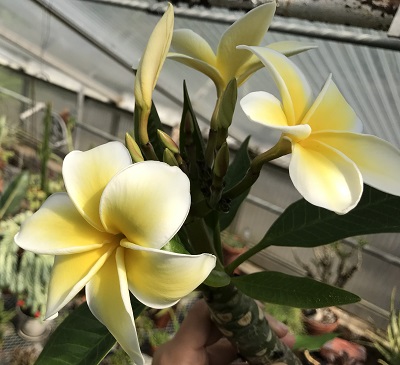
Frangipani
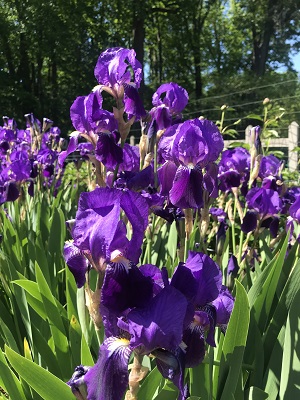
Iris
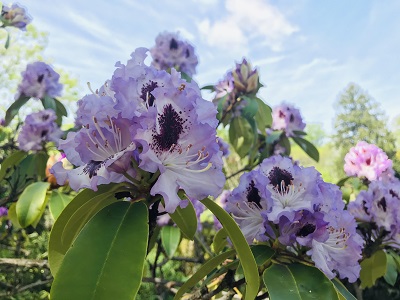
Rhododendron
Update from the Rose Parterre
We are ecstatic to welcome a number of new roses into our permanent collection. Here’s a sneak peek of Silver Lining and Ketchup and Mustard:
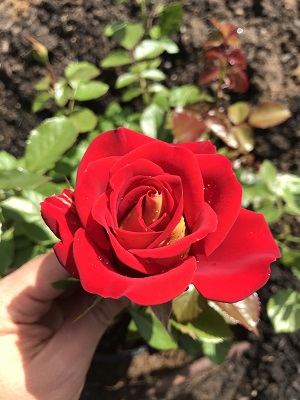
Ketchup and Mustard
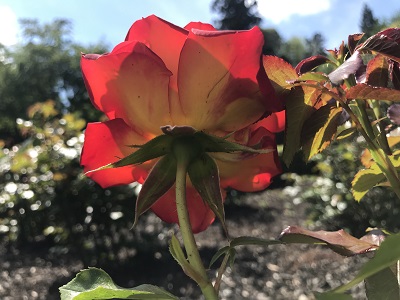
Ketchup and Mustard

Silver Lining
(posted 5/4/2021)
Ajuga Bugeweed
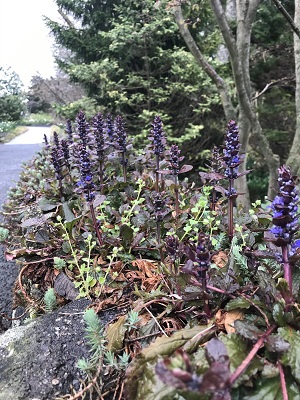
Our Rockwall Garden is beautiful at every season thanks to the Ajuga. We love its colorful foliage during the winter and pretty blue flowers in the spring.
Arisaema
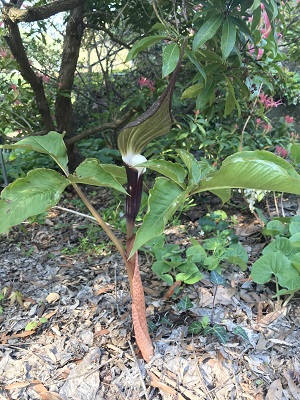
This amazing Jack-in-the-Pulpit is native to Japan and is featured in out Japanese Garden alongside the Display Greenhouse.
Aucuba
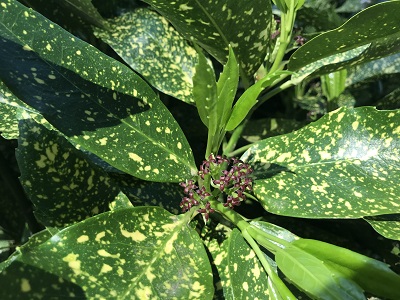
Also known as Spotted Laurel, this lovely evergreen bush is a great addition to our Japanese Garden and is currently in bloom.
Bitter Orange
A single specimen, this Bitter Orange, also called Hardy Orange, can be found in our Japanese Garden growing between the maples. In early spring, its white blooms are fragrant with sweet citrusy notes, and in the fall, its small green fruits are ready to pick.
Bleeding Heart Hill
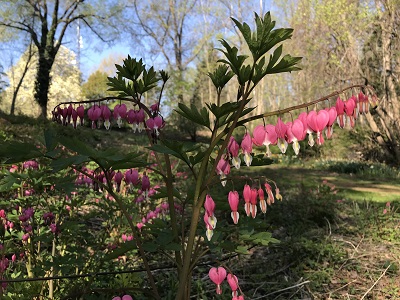
Have you seen our Bleeding Hearts covered hill yet? If you have not, now is the perfect time to experience this beauty of nature. Stop by the Horticultural Center and ask the staff to point you in the right direction.
Bonsai
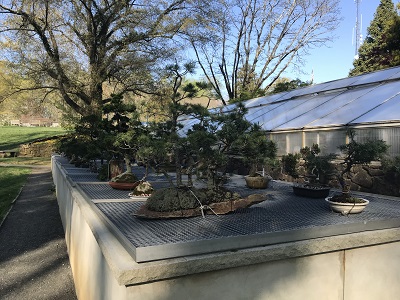
With over a 100 specimens in our collection, the Bonsai trees are back out on display. Several are currently in bloom.
Corydalis
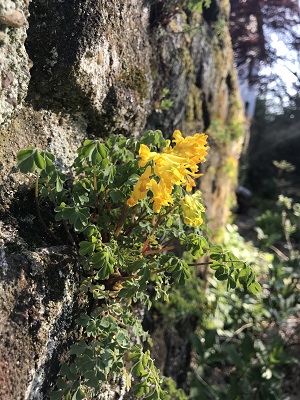
The rock wall on the Japanese Garden is a structural feature, yet thanks to the hardiness of the Corydalis, it is a beautiful landscape with bright yellow blooms almost all year-round.
Enkiantis
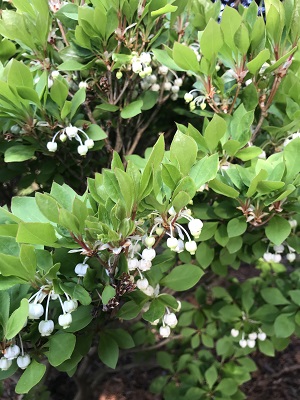
This dwarf Enkiantis is currently blooming in our Japanese Garden.
Hosta
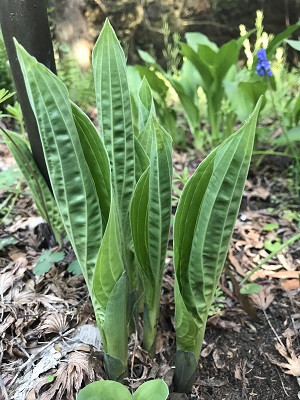
We love Hostas (as much as the deer) and with so many different varieties, our landscape is like a small catalog. These shoots, also called hastons, are currently breaking the ground in our Japanese Garden.
Kerria Japonica
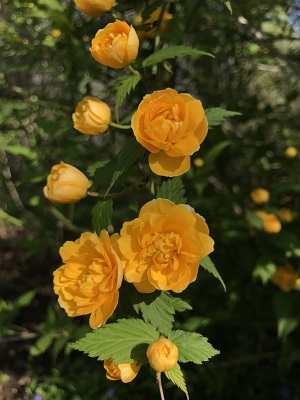
This Japanese rose has the most striking yellow blooms. You can see them from across the field; perhaps, that is why the hummingbirds never miss visiting it.
Lilac
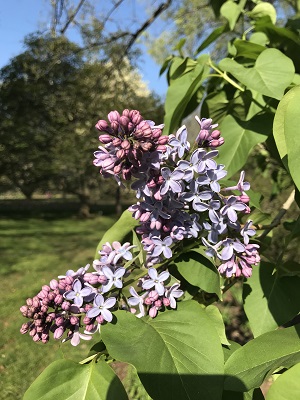
The lilacs are starting to bloom here at Deep Cut Gardens. We love their fragrance and seeing all the bees and butterflies helping themselves to the pretty blooms.
Primrose and Azalea
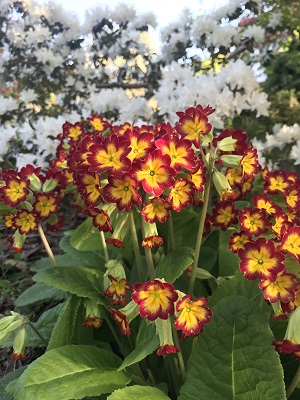
These contrasting colors are the welcoming sight of the Japanese Garden entrance. Take the detour and experience this packed full of treasures garden.
Trilium
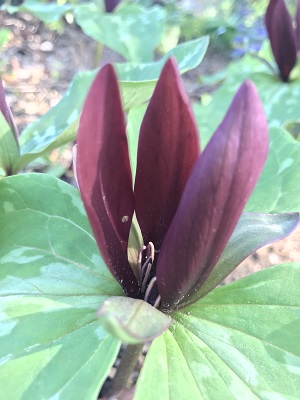
Look at these beautiful leaves and their perfect symmetry! Triliums are currently blooming in our Japanese Garden. Some species of trillium are listed as threatened or endangered and collecting these species is illegal. Did you know that ants are the seed dispersal agent of the trulium plant?
Trout Lily
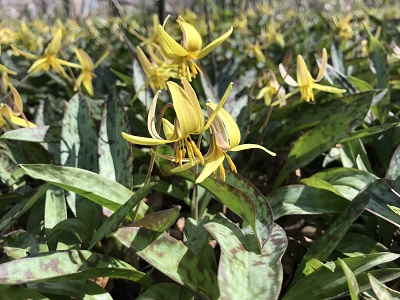
Erythronium americanum, also known as Yellow Trout Lily, is common native flower. Its leaves resemble the pattern and coloration of the Brook Trout hence the name.
Viburnum
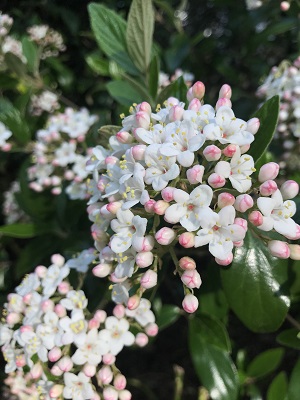
Aptly dubbed “the wedding cake,” tiered white flowers along deciduous branches have an unmistakable layered effect. (posted 4/26/2021)
Tulips, Daffodils & Primrose Garden
Deep Cut is exploding with color! From a sea of yellow, red and purple tulips to buttery daffodils, spring welcomes us in all its beauty.
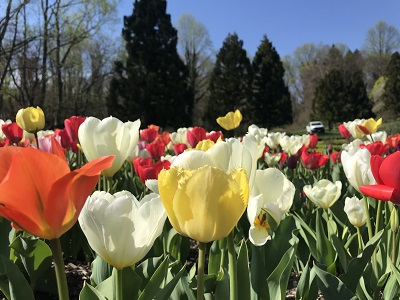
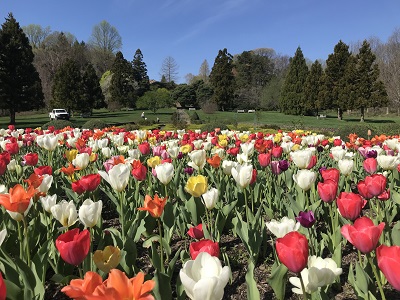
Tulips
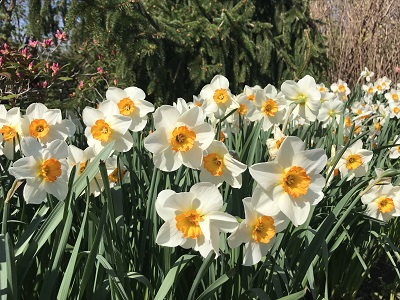
Daffodils
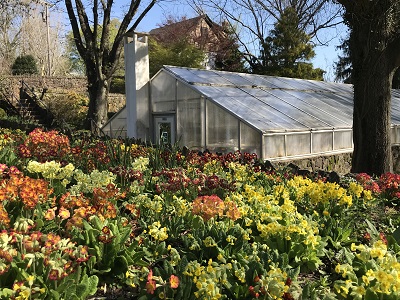
Primrose Garden
(posted 4/20/2021)
Magnolia acuminata Elizabeth
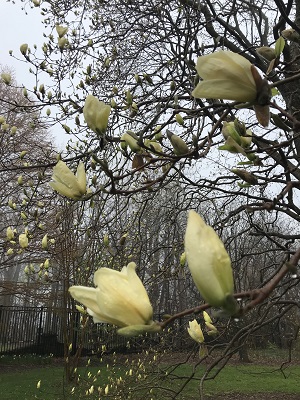
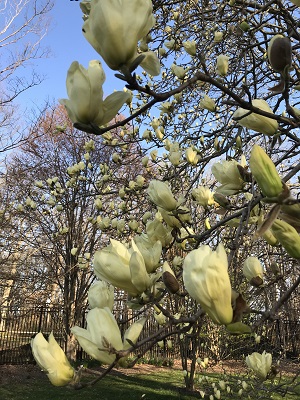
This amazing magnolia tree is what many of our staff and visitors look forward to each year. The blooms show up a week or so later than the pink magnolia. Their color is bright to buttery yellow, gradually fading towards white as the blooms mature.
Virginia Bluebells
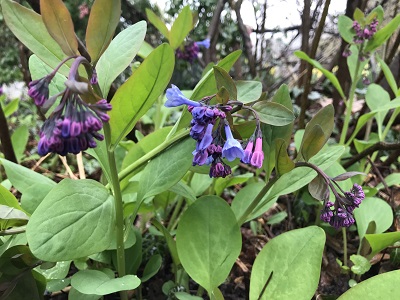
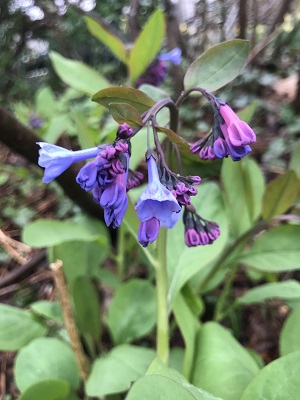

Virginia Bluebells (Mertensia virginica) are one of our favorite spring ephemeral flowers! This beautiful plant grows well in part shade gardens and comes back every spring to lure pollinators and admirers of its changing blue colors.
Early Rhododendron
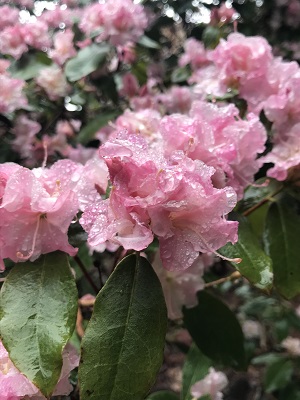
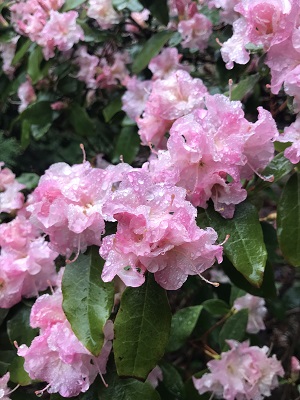
If you find yourself taking a walk in our rock garden, you will discover this beauty tucked away under the Sargent Weeping Hemlock trees. (posted 4/12/201)
Tulip Update - April 12
Our gorgeous tulips are enjoying the rain showers this morning. We love it too – “April showers bring May flowers.”
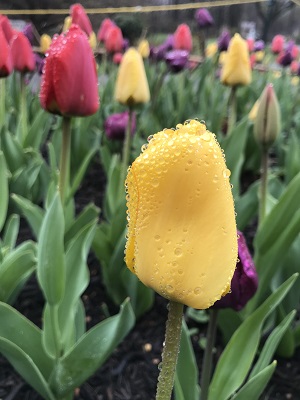

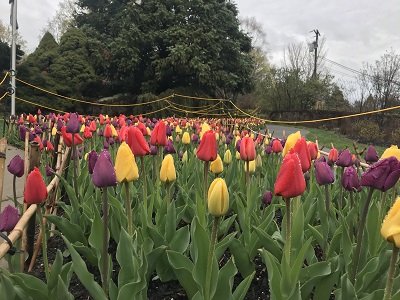
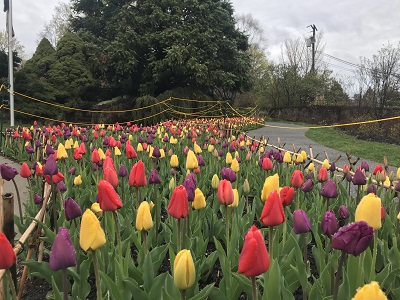
(posted 4/12/2021)
Tulip Update - April 7
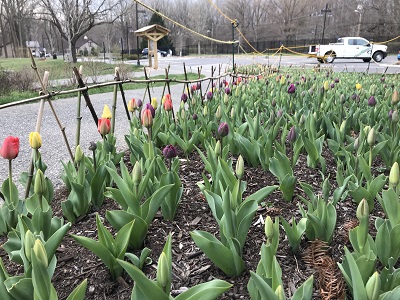
Our tulip display beds are starting to show a bit of color! While some early bloomers are open, the majority of the tulips are still in buds and we are still a few days away from an all-out sea of color.
The magnolia trees are stunningly adorned with pink hues, our daffodils are in full bloom, and the air smells heavy with hyacinth’s aroma. The birds are busy singing and the koi are enjoying the spring sunshine. (posted 4/7/2021)
Easter Cactus
Schlumbergera gaertneri aka Spring Cactus
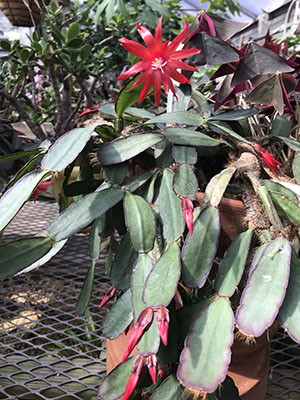
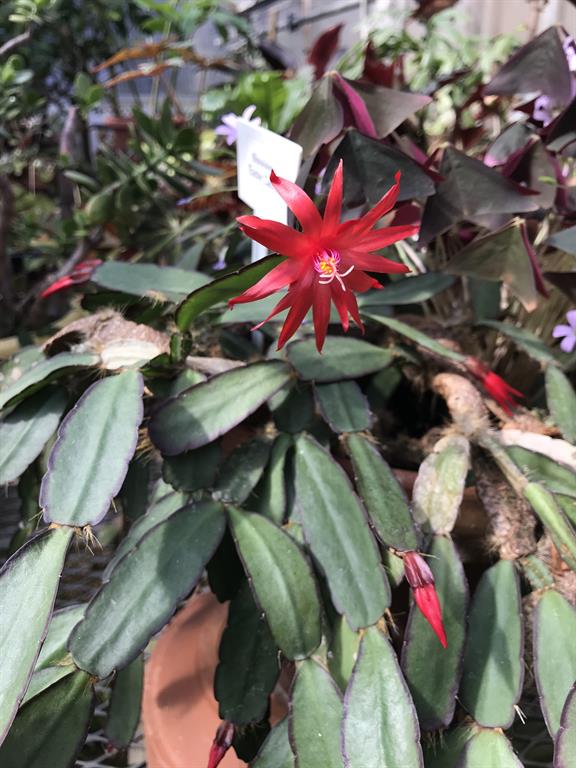
The flowers are a big draw on this plant. They are starshaped, different than the Christmas and Thanksgiving Cacti.
Poinsettia
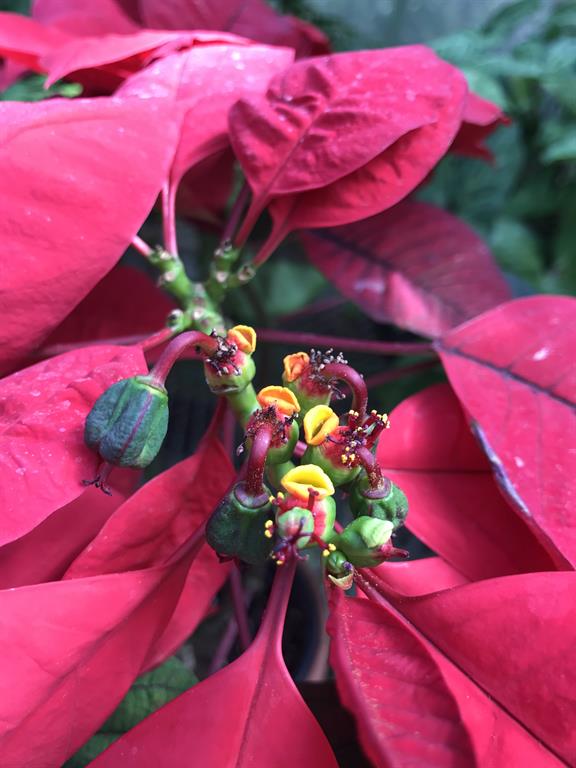
Indigenous to Mexico and South America, this ornamental beauty is currently flourishing in our greenhouse months after it was part of our holiday decorations.
String of Pearls
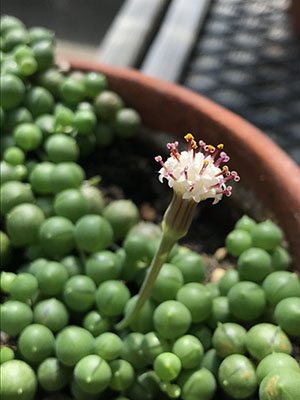
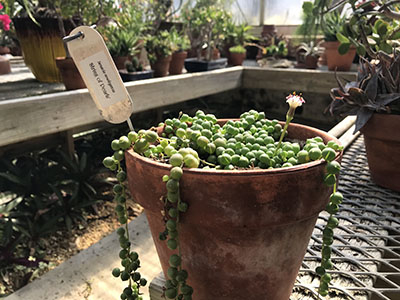
Native to the dry lands of Southwest Africa, this creeping succulent vine is perennial with amazing specialized leaves in the shape of pearls. Botanists describe its flower as “disco ball.” Do you see the resemblance?
Walking Kalanchoe
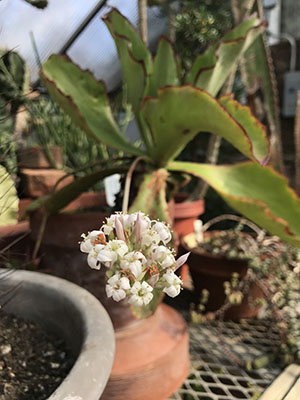
The Kalanchoe synsepala, or Walking Kalanchoe of the Crassulaceae family, is a succulent with its origins in Madagascar. The Walking Kalanchoe is a fairly common house plant. Its name comes from its unusual adaptation of sending off long stems with new plants as if it is walking.
Bonsai Zhuzhou Fuchsia
Loropetalum chinensis aka Chinese Fringe Lower
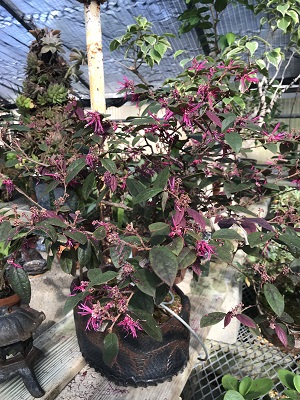
Native to China and the Himalayas, this evergreen flowering shrub in highly prized for its dark, almost black, foliage and fragrant purple flowers.
Croton A and B
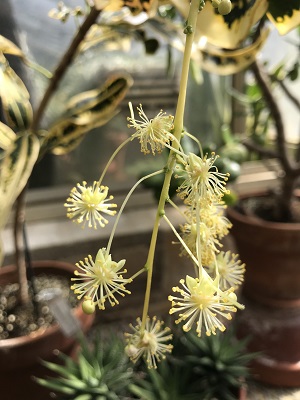
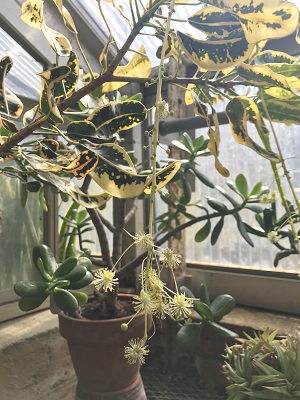
Croton A
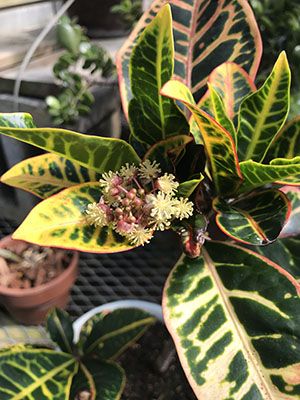
Croton B
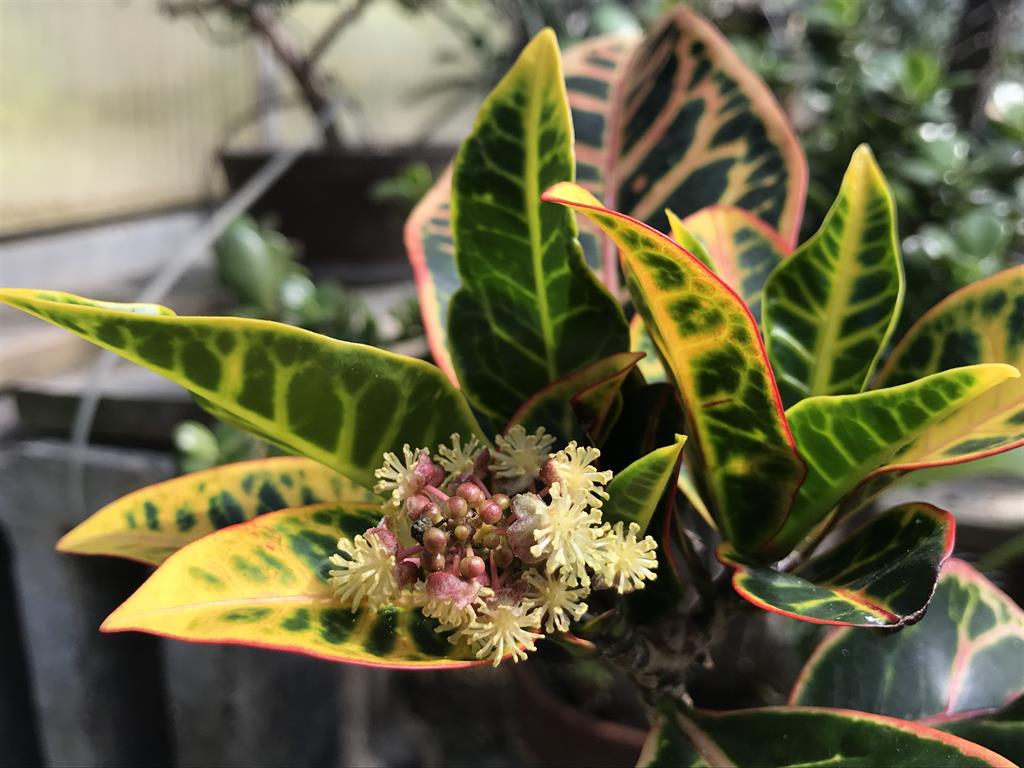
Croton B
Croton 'Petra' (Codiaeum variegatum 'Petra') is an evergreen shrub native to southern Asia, Malaysia and the western Pacific islands. Croton “Bush on Fire” is another species in the same family with specific, rich-soil requirements. In our region, both are common house plants.
Cactus
Gymnocalycium cactus common name Chin Cactus
Popular as a house plant and green house specimen due to flowering capability, its blooms are distinct in that they do not have any hairs or spines and are adored for their bright colors.
Paph. Orchid
Paphiopedilum henryanum
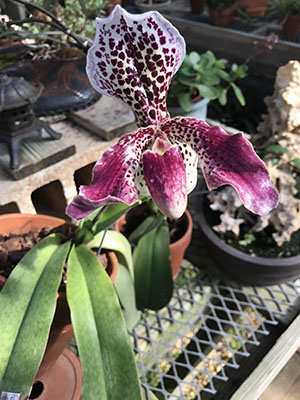
This tropical hybrid slipper orchid is different from the common moth orchids because it is terrestrial (grows on the ground). It gets its name from the one petal that is curled in the shape of a slipper. (posted 4/6/2021)
Star Magnolia
Fragrant white (or pink) flowers emerge from conspicuously wooly covered buds in early spring and are loved by people and pollinators alike. Currently, Star Magnolias can be seen lining the walk from the pergola in the rose garden to the pond.
Buttercup Winterhazel
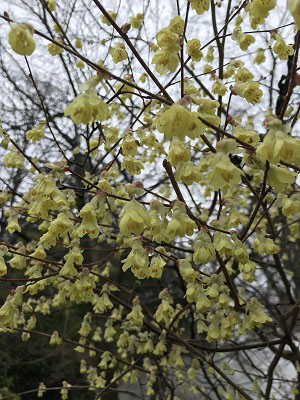
Buttercup Winterhazel is native to Japan and Taiwan. It gained the English name "buttercup" for the fragrant buttery-yellow blossoms that herald spring. Currently, it is in full bloom in our Japanese Garden.
Spike Winterhazel
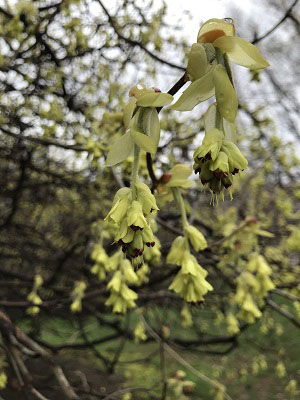
Spike Winterhazel (Corylopsis spicata) is a sweet-scented flowering shrub with beautiful yellow flowers. It is perfect for the woodland garden as it can tolerate partial shade.
Hyacinth
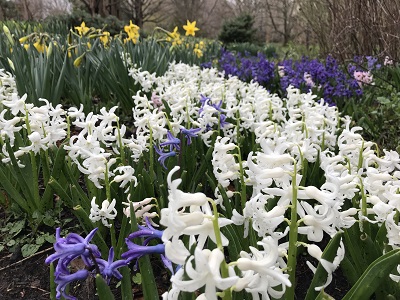
These beautiful bulbs come back every spring and fill the garden with their powerful perfume smell. Bloom colors range from white to cream, blues and pinks.
Forsythia
These popular early spring flowering bushes can be seen anywhere from the garden and your neighbor’s yard to roadsides and woods. Here at Deep Cut, we also have white flower forsythia.
Tulip Update
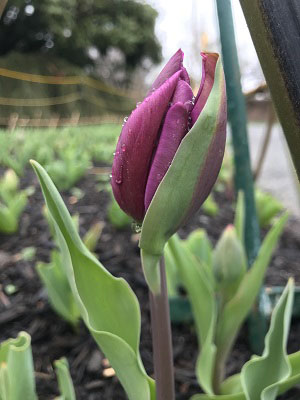
Some of the earliest buds are appearing! (posted 4/1/2021)
Persian Ironwood
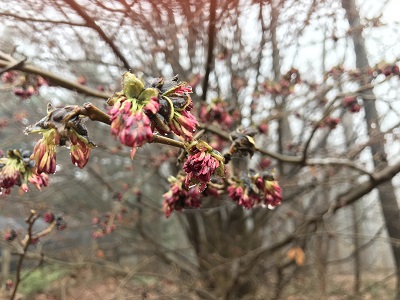
Parrotia persica, Persian Ironwood, is a deciduous tree in the family Hamamelidaceae – a close relative to the witch hazel (which is also currently in bloom). The tree is native to Iran and is on the endangered species list.
Daffodils

Walking in the garden or on any of our trails, you will see the clumps of the bright daffodil blooms all around you. We have over 10 different varieties blooming throughout the property.
Violets
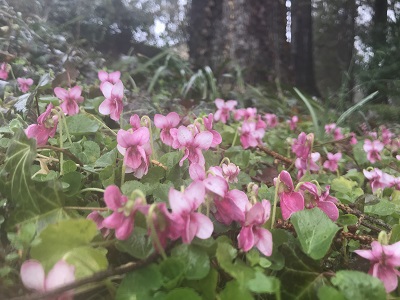
Stop by the shade garden and enjoy this carpet of pink violets.
Japanese Andromeda
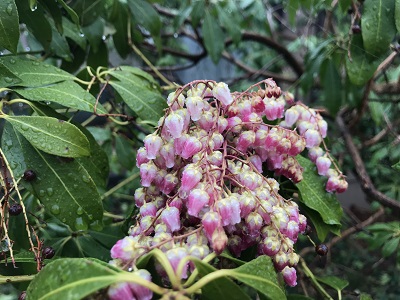
Pieris japonica, Japanese Andromeda - there are several different cultivars currently in bloom in the garden. Their beautiful flowers range from white and cream to pink and magenta.
Tulips
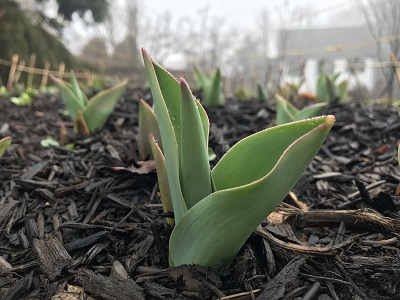
Our tulip bulbs have sprouted and are breaking the ground. With each passing day, they are taller and stronger. We can’t wait to see them bloom.
Rose
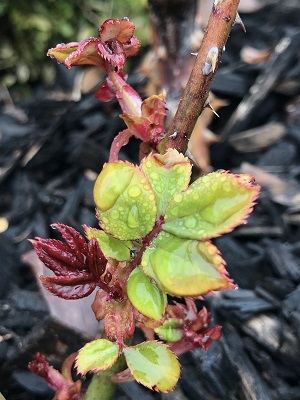
The roses in our garden are starting to wake up from their winter slumber.
Tree Peony
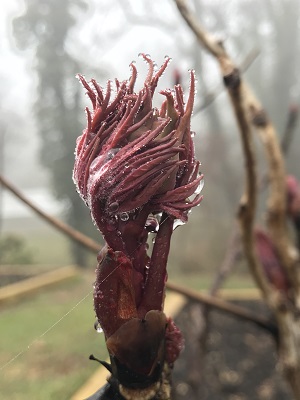
Our tree peonies are a real treat for the eyes when they bloom. Their flowers are rich and full of color. Although not currently blooming, this tree peony bud is just as captivating with its deep red color. Tree peonies are larger, woody relatives of the common herbaceous peony, growing up to 5 feet (1.5 m.) wide and tall.
Sweet Box
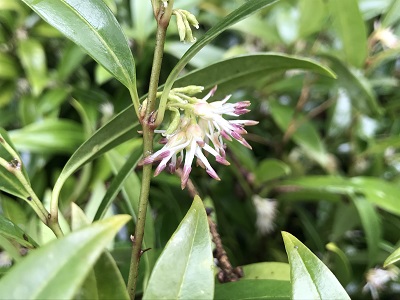
Sarcococca, aka Sweet Box, is a flowering plant in the box family. The plant is native to Asia and the Himalayas. It blooms early spring and has a fragrant white flower.
Squill
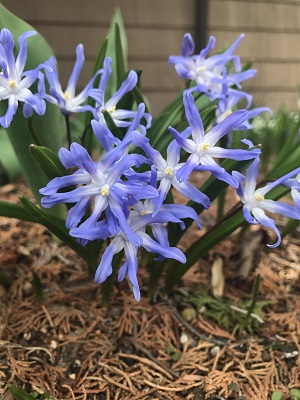
Scilla, known as Squill, is bulbous perennial plant native to Europe, Africa and the Middle East. It is commonly cultivated for its bloom. In early spring, each plant will produce three to four flowers in striking blue color.
Anemone blanda
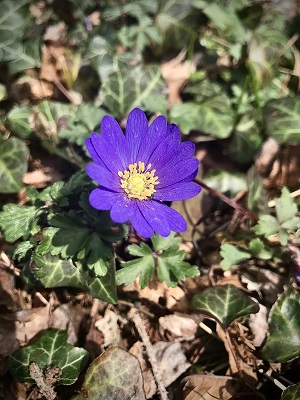
Anemone blanda is a winter wildflower in the family Ranunculaceae. Native to the Eastern Europe, its flower is blue, pink or white. (posted 3/26/2021)
Crocus Flowers
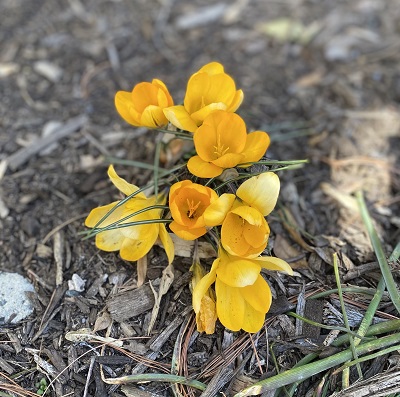
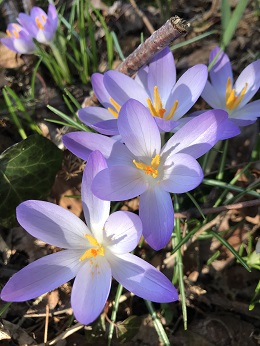
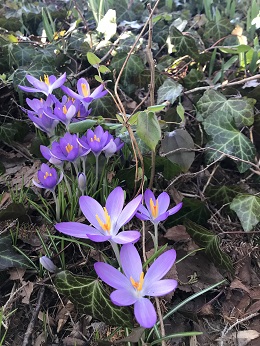
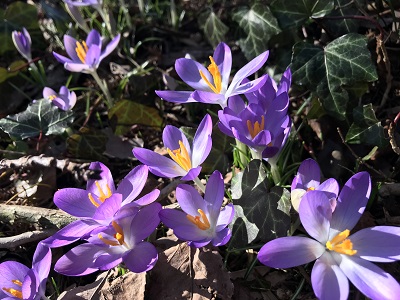
These beautiful blooms mark the arrival of spring in the Northern Hemisphere adoring meadows, suburban lawns, coastal gardens and woods alike. Crocus plants grow from bulb-like structure called corm. They are hardy and often bloom through the snow. Crocus spp. belong to the iris family Iridaceae.
Tadpole
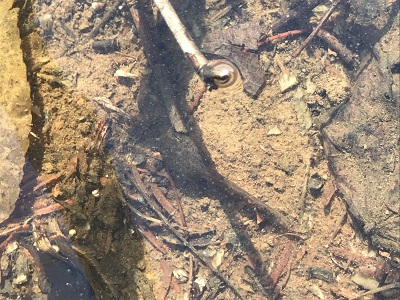
Plants support life even when they are no longer living. Leaves and sticks that fall into ponds provide essential habitat and key support to wildlife. Pictured here is a tadpole camouflaging amongst the elements. Freshwater snails feed on and use dead leaves for their eggs.
Magnolia Bud
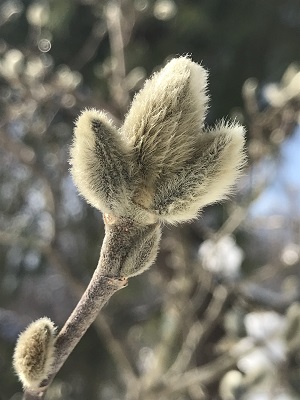
Plants have evolved to protect their precious buds, assuring new growth and propagation. In this photo, you can see the magnolia buds are covered in soft, fuzzy growth to protect them from the frost.
Skunk Cabbage Flower
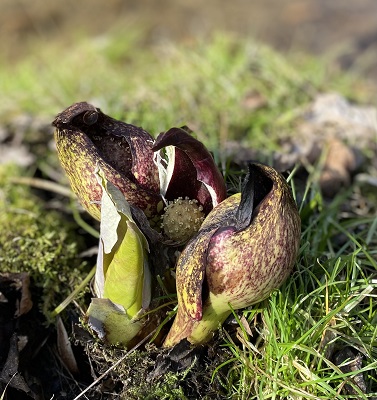
Symplocarpus foetidus, commonly known as skunk cabbage or swamp cabbage, is an interesting wetland plant that gets its name from its foul odor. The skunk cabbage is native to eastern North America. Very early in spring, the greenish-yellow spadix (pictured here) of this plant appears, enclosed by a reddish-brown spathe that is open at one side. As the flower wilts, the green cabbage-like leaves begin to grow. (posted 3/10/2021)
Witch Hazel
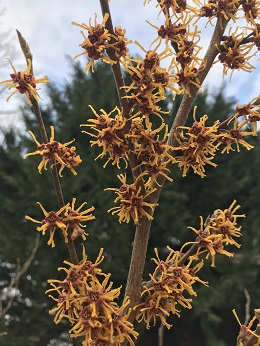
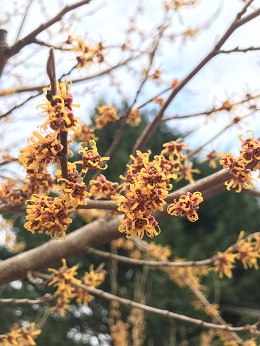
We love the unusual, bright, and fragrant flowers of the Witch Hazel mostly because they bloom during the dormant cold months. They first open in winter, usually during a warm spell, but the flowers don’t die when the temperature drops back down. Instead, the ribbonlike petals curl up temporarily, and as soon as the temperature rises, they unfurl again. This particular one has a distinctive cinnamon-like aroma. (posted 1/15/2021)
Holly
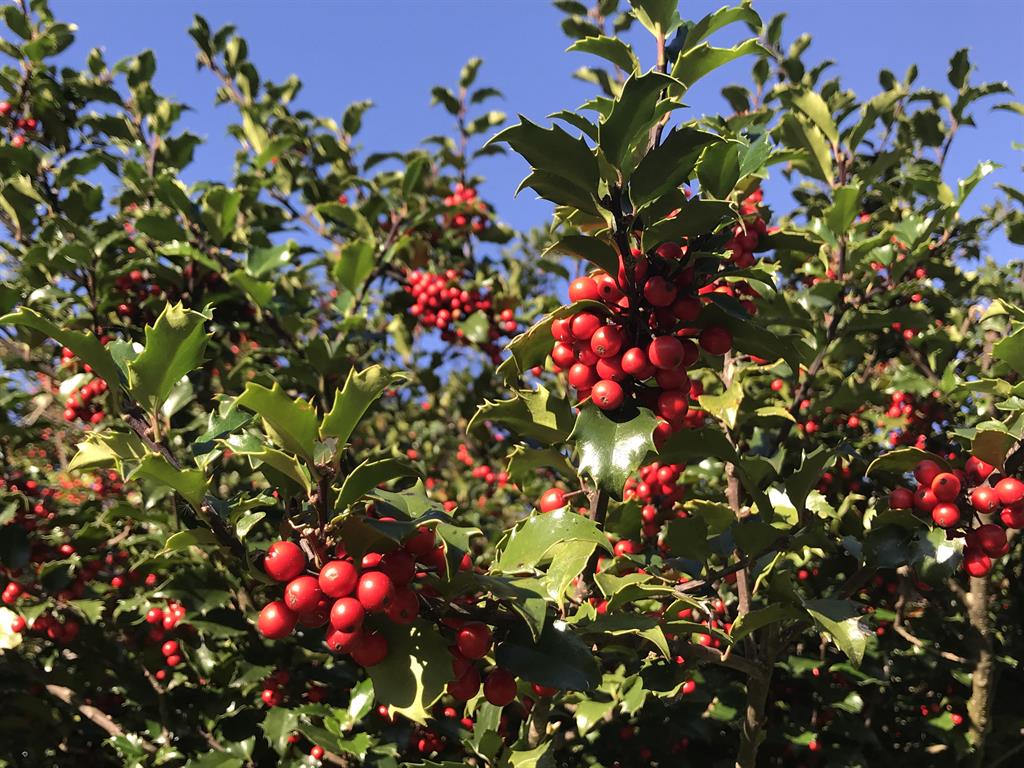

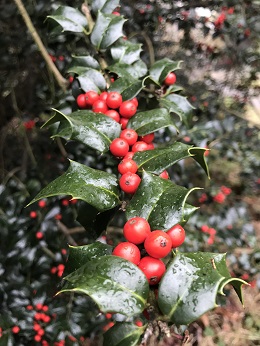
Holly flowers, Holly berries! Holly is the birth flower for December, symbolizing happiness and optimism. Did you know its small flowers are unisexual and have four petals, the male and female flowers are usually borne on separate plants? (posted 12/9/2020)
Echeveria
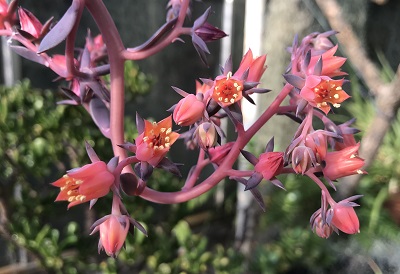

If succulents are your passion, stop by our greenhouse and see this stunning Echeveria in full bloom. The flowers open sequentially and will last for few weeks. (posted 12/4/2020)
Bromeliad Aechmea fasciata “Primera”

Aechmea fasciata is an epiphytic growing bromeliad native to the rainforests of Brazil. It is commonly sold as a house plant. Keep it in sunny, warm and moist environment and the flower will last for weeks on.
Bougainvillea spp.
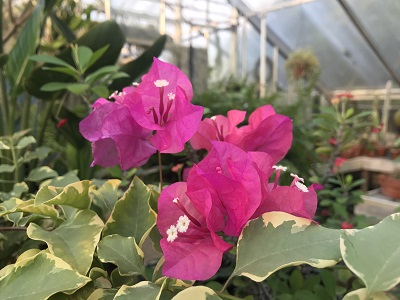
The bougainvillea was discovered in 1768 in Rio de Janeiro by French naturalist Dr. Philibert Commerçon. This equatorial plant is virtually pest-free and disease resistant with bold tropical colors when in bloom. It is easily trained in pots and therefore a bonsai favorite.
Melocactus
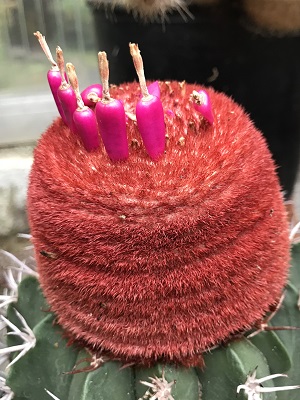
Melocactus “Turk's cap” is native to southern Mexico; these plants produce distinctive woolly and bristly cap-like structures. The cap-like structure resembles a Fez hat, hence these plants are commonly known as Turks Cap Cactus. Flowers develop into edible pink fruits, shaped like peppers.
Thanksgiving Cactus Schlumbergera truncate &
Christmas Cactus Schlumbergera bridgesii
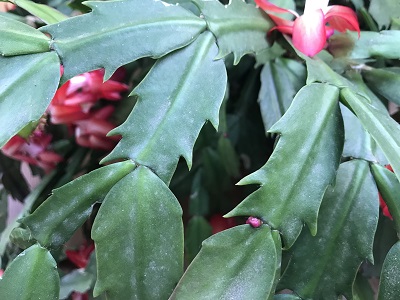
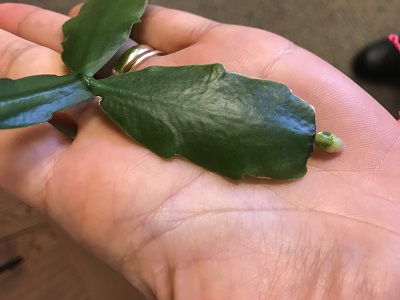
Thanksgiving Cactus Christmas Cactus
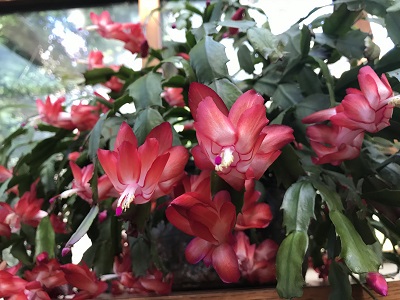
Thanksgiving Cactus
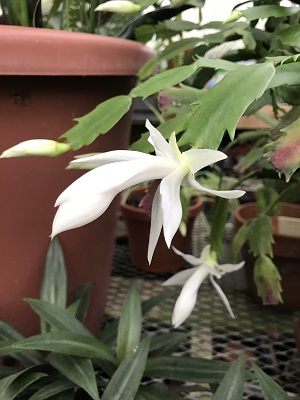
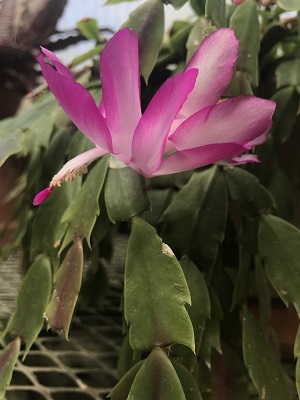
Thanksgiving Cactus
Thanksgiving cactus (Schlumbergera truncate) and Christmas cactus (Schlumbergera bridgesii) are common houseplants with cuttings being passed on from generation to generation. These holiday succulents are often mixed up. To tell them apart, look at their leaves. The Thanksgiving cactus has serrated and pointy leaves resembling a crab claw. The leaves of the Christmas cactus are more rounded and scalloped on the edge. (posted 11/18/2020)
Ginkgo biloba

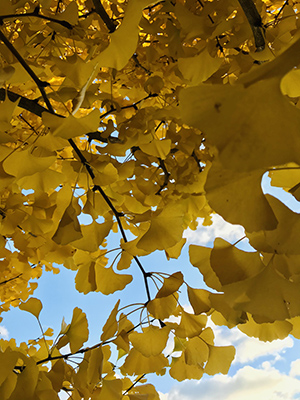
Also known as Ginkgo, fossil tree, maidenhair tree, Japanese silver apricot, baiguo and yinhsing, it is one of the oldest living tree species in the world. Ginkgos are prized for their autumn foliage, which is deep saffron yellow. (posted 11/18/2020)
Corydalis
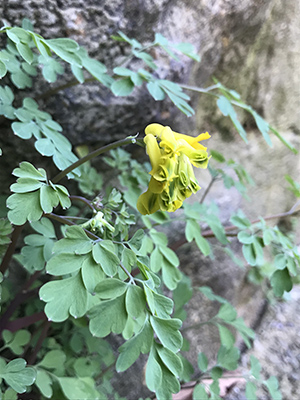
Our rockwall is adorned with yellow blooms all year around, even in the winter the corydalis flowers persist and we love its delicate foliage. (posted 11/18/2020)
Pineapple Sage
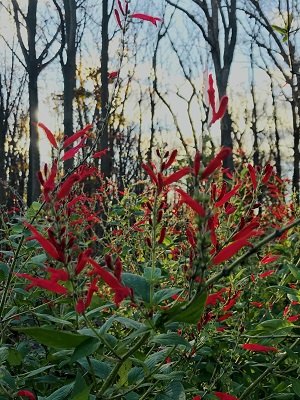
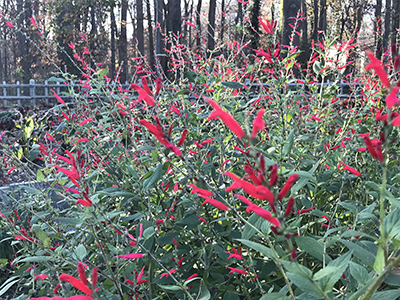
It's cold out! Yet, look at the burst of drama and show-stopping blooms. The flowers of the pineapple sage are tubular with two distinct lips. To say that they are red doesn’t go far enough; they are intensely scarlet. Pineapple sage (Salvia elegans) is also known as Hummingbird sage and is a late blooming herb. Its leaves have a distinct pineapple aroma and are used fresh in teas and cocktails.(posted 11/18/2020)
Camellia
One of the very best flowering shrubs with evergreen foliage, it begins blooming in the fall and continues throughout the winter when everything else in the garden is asleep.
Clove Pink
Clove Pink is a hardy perennial with greyish-green to blue-green slender leaves and intensely sweetly scented bright pinkish-purple flowers that attracts butterflies.
Celosia
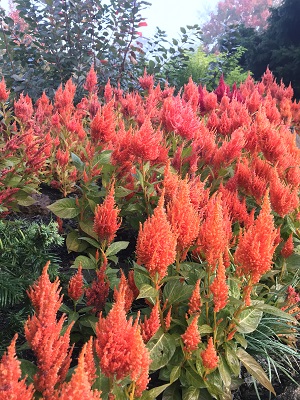
Some species of celosia are used as annual ornamentals like this C. plumosa, with fluffy, plume-like inflorescences, also known as “paint brush plant”.
Cyclamen
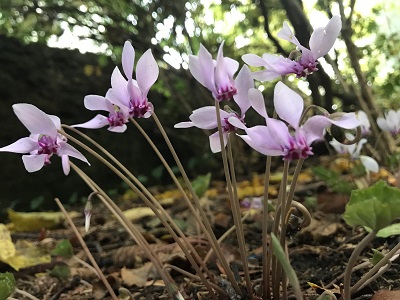
Also known as Persian Violet, this flower is native to Central Europe and the Mediterranean region to Iran.
Chrysanthemum
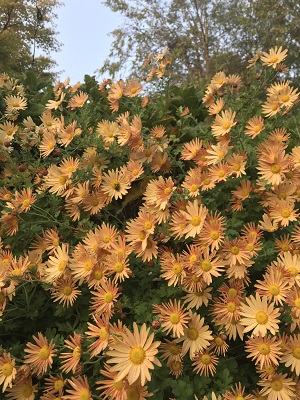
This fall blooming perennial grows easily with minimal maintenance. We recommend cutting back dead stalks each spring and pruning until the Fourth of July for thicker blooms. Most garden mums are hybrids that originated from species native to Russia, China or Japan. Early hybridization of these plants occurred in China as far back as 500 A.D.
Orchid Cattleya
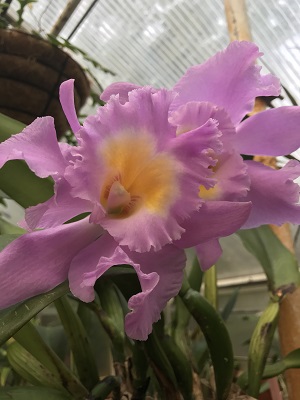
These orchids are native to South America. They are prized for their large showy flowers and are commonly used in corsages and wedding bouquet as their blooms can last up to a month.
Japanese Anemone
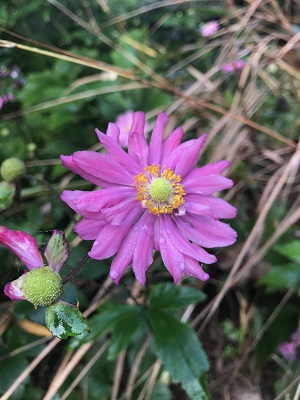
A beautiful fall blooming perennial with semi-double, rose pink flowers produced above a large mound of dark green foliage. The plant spreads slowly through rhizomes and it is a great alternative to mums. (posted 10/21/2020)
Autumn crocus
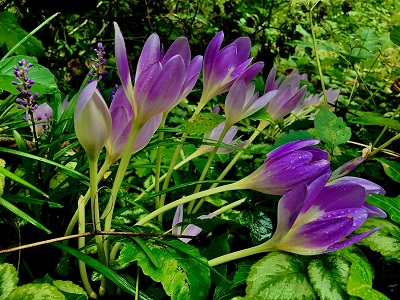
Autumn crocus Colchicum autumnale resembles true crocus, yet it's a hybrid that belongs to the lily family (Lilaceae).
Hurricane lilies
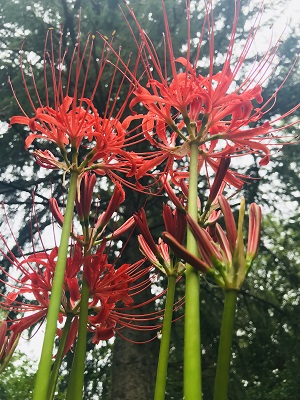
Hurricane lilies (Lycoris radiata) are currently blooming in our Japanese Garden. These beautiful flowers are members of the Amaryllis family that bloom in September. They are winter hardy for USDA zones 5 - 10.
Dendrochilum magnum
Dendrochilum magnum is currently blooming in our greenhouse. This orchid is from the Philippines, where it is found growing on trees. Other known names are “golden chain orchid” and “chain orchid” because of the flower formation. (posted 9/22/2020)
Vinca “Jam and Jellies”
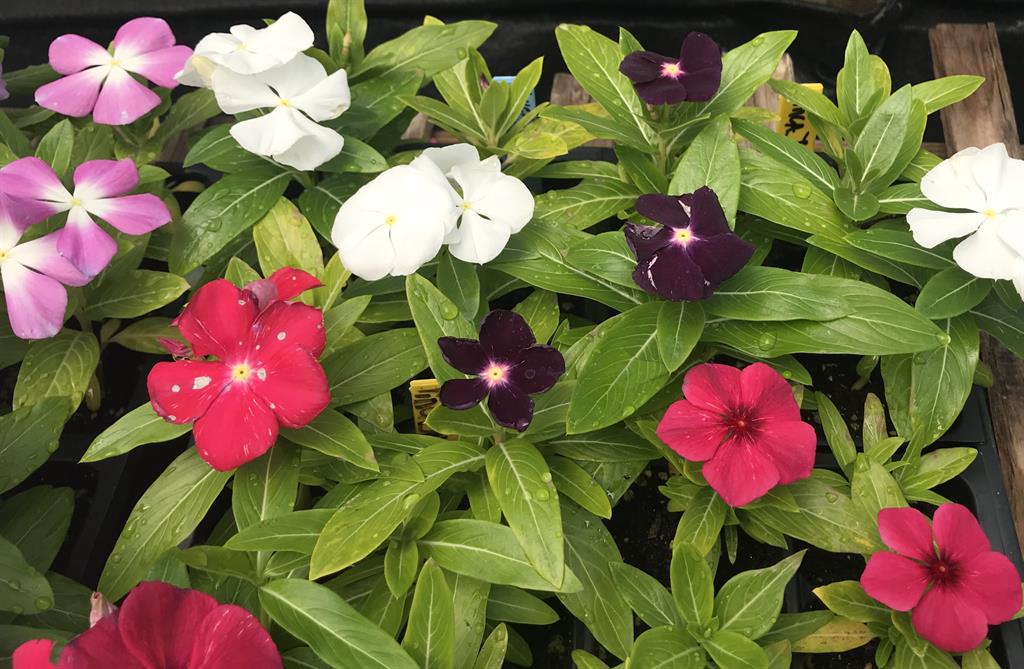
These beautiful long lasting and continuous blooms adore our garden borders. Easy to grow
and care – annual.
Zinnia spp.
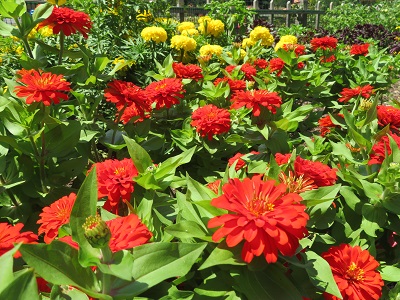
The pollinators just can’t resist the zinnia blooms. It is a must have for any butterfly garden.
Blue Plumbago
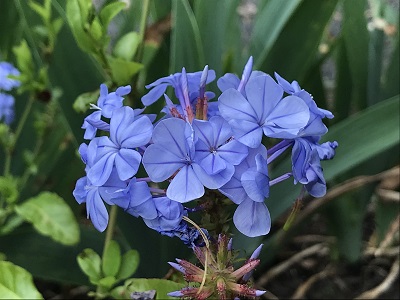
The pretty blue color of the blooms always attracts the attention of garden visitors. Everyone loves
blue flowers.
Calendula
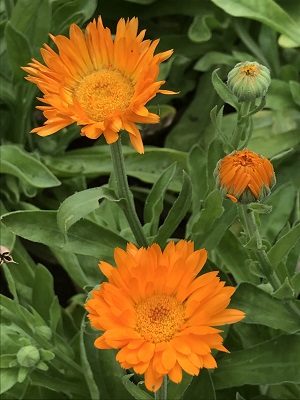
There are so many reasons to love calendulas including the fact that the flowers are edible.
Canna South Pacific Orange
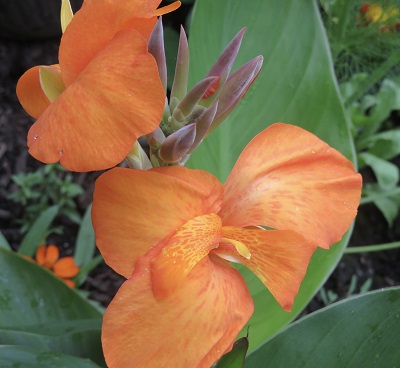
We love the low border of these compact plants, yet their soft orange color makes them most special.
Canna Tropical Rose
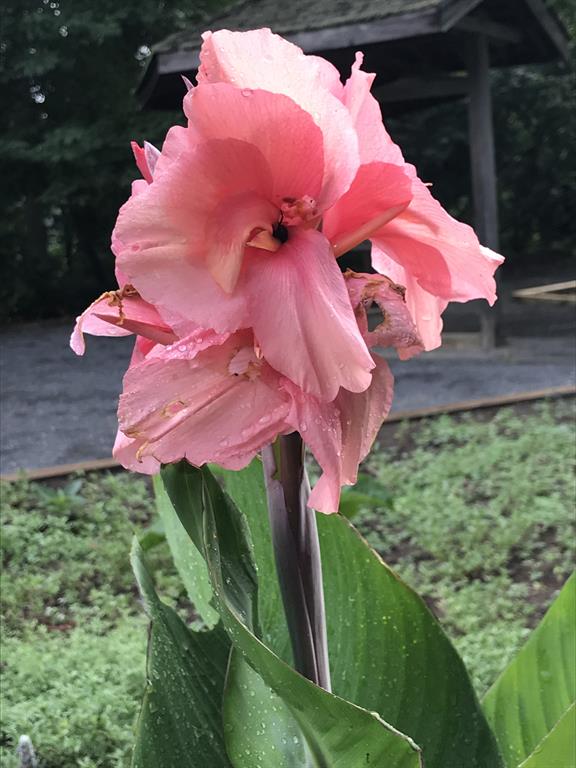
Tropical Rose continues to produce flower spikes all summer for reliable color in a garden.
Coneflower
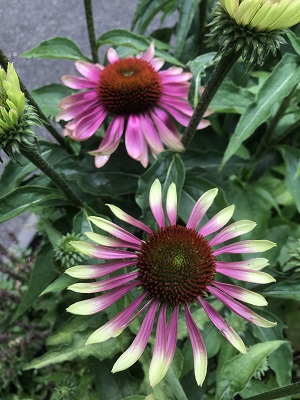
Most summer flowers bloom for few days yet the blooms of the cone flowers last for a month. The gold finches love to eat the seeds.
Rubeckia
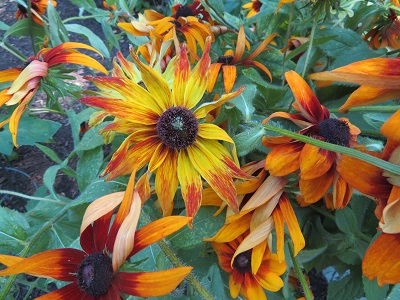
Incredibly easy to grow and pollinators love it.
Marigold Big Duck Yellow
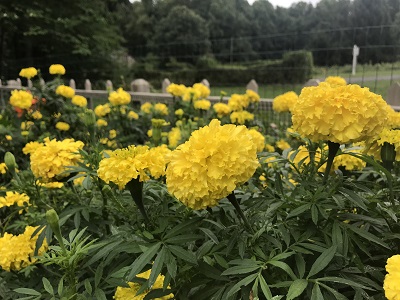
This follow has long lasting color with great heat and disease tolerance.
(posted 9/18/2020) Monarch Caterpillar
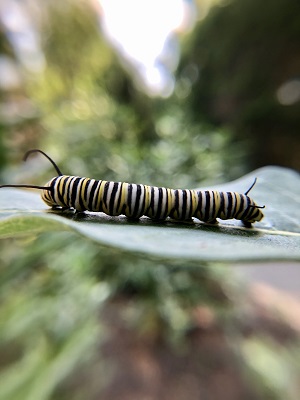
The Monarch Butterflies are back and they are loving our flowers. The milkweed patch is now home to their new generation. We can't be happier. (posted 7/30/2020)
See What's Blooming!
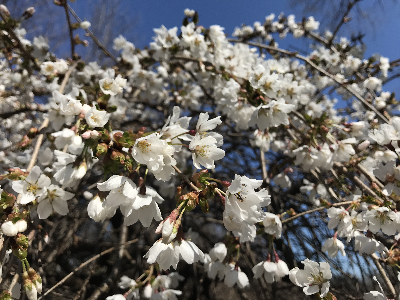
Mid-March Blooms
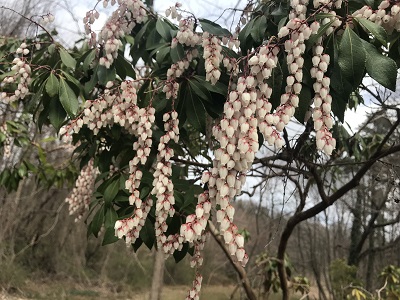
Pieris Japonica "Dorothy Wycoff"
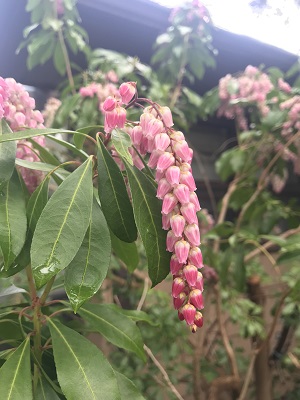
Pieris Japonica "Flamingo"
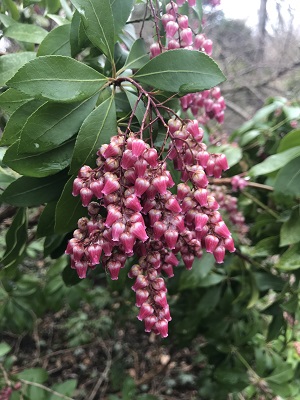
Pieris Japonica "Valentine's Day"
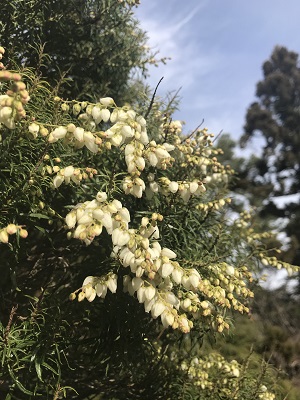
Pieris Japonica "Pygmaea"
Japanese Pieris is an evergreen shrub thrives in the shade and provides four-season interest to your garden. For a beautiful border pair, it with rhododendrons which share the same acidic soil preference. (We have several cultivars of them at Deep Cut Gardens.)
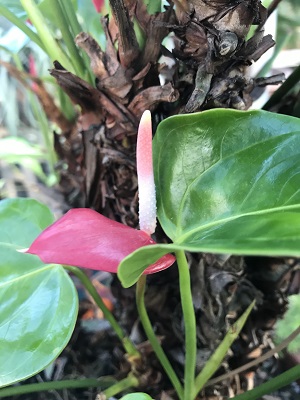
The Flamingo Lily is a popular house plant in bright and humid areas, as it is a tropical epiphytic evergreen native to Colombia and Ecuador.
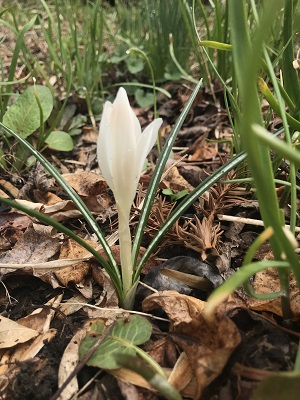
Dutch Crocus
Did you know that the Dutch Crocus flowers close at night and re-opens during the day?
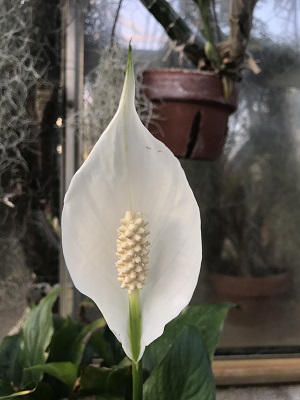
Peace Lily
This plant is not related to the true lilies at all. Although it is a popular house plant it is not safe for pets and young children as it contains calcium oxalate—a substance that may cause stomach and respiratory irritation if ingested in large amounts.
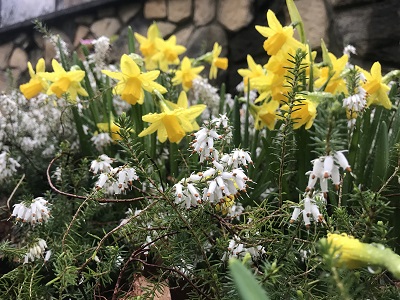
Winter Heath
These hardy, low-growing plants produce a wide variety of bell-shaped or tubular pale pink, reddish-purple, and magenta flowers for what seems like an eternity - - October and November into April and May. Perfect evergreen ground cover they are members of the large Ericaceae family, which also includes rhododendrons, azaleas, and blueberries.
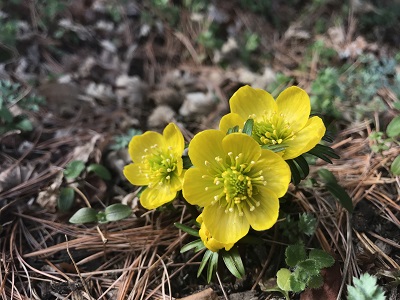
Winter Aconite
Winter Aconite is native to Europe (France to Bulgaria) and is perfect for rock gardens, along paths or walkways. (posted 3/17/2020)
More Blooms!
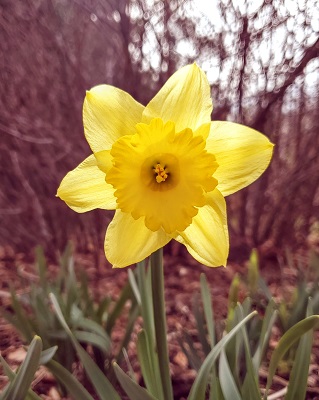
Daffodil
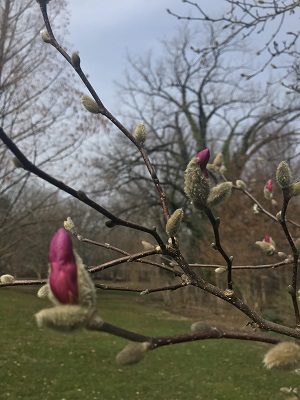
Saucer Magnolia in bud
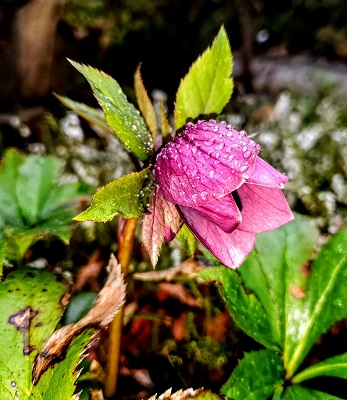
Hellebore
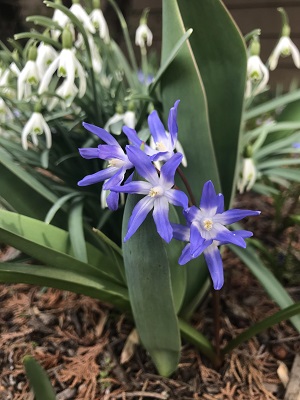
Squill (Scilla siberica)
See the earliest signs of spring in the gardens!
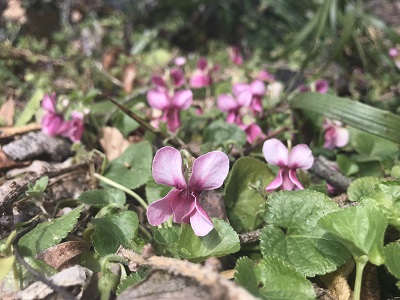
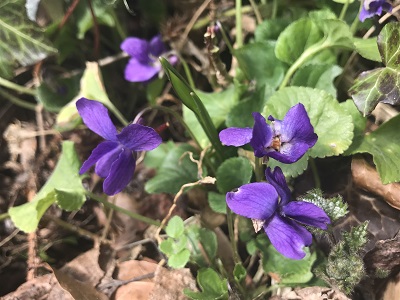
Violet (Viola sororia) - It's our state flower.
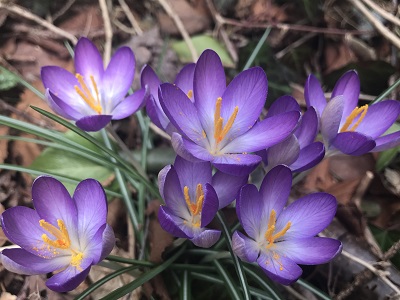
Crocus
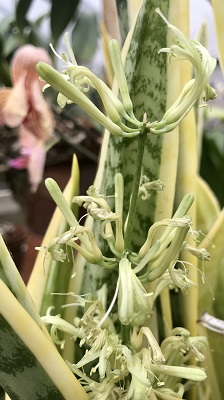
Snake plant (Dracaena trifasciata)
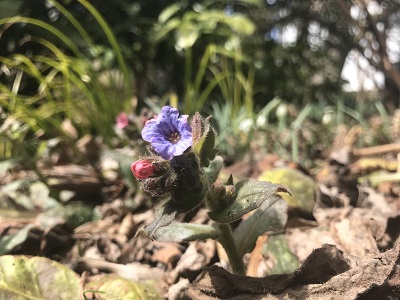
A barely open Lungwort (Pulmonaria saccharata)
(posted 3/10/2020)
What's in Bloom
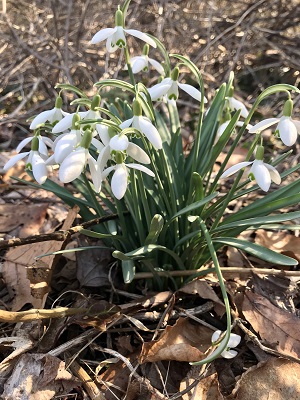
Snow Drop (Galanthus)
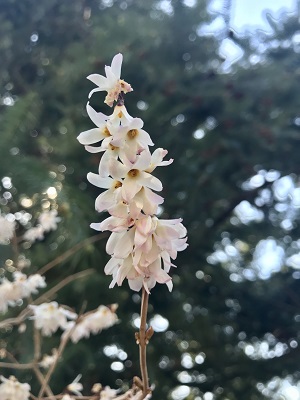
White Forsythia (Abeliophyllum distichum)
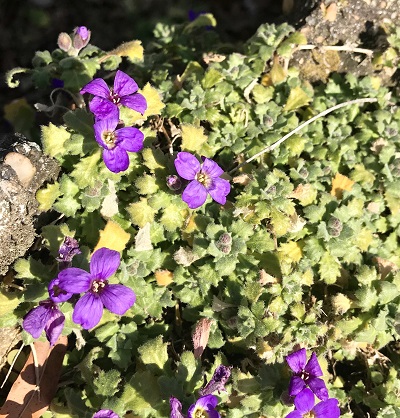
Purple Rock Cress (Aubrieta deltoidea)
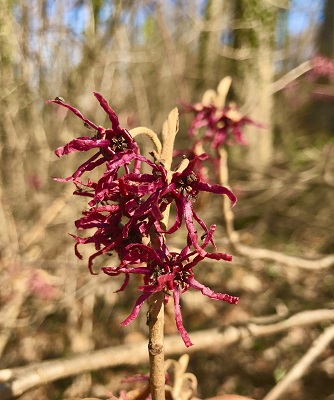
Witch Hazel (Hamamelis x intermedia cv. Diane) (posted 3/3/2020)
What's in Bloom
Even though it's February, there are flowers to enjoy in the greenhouse and even some dispersed throughout the garden. Come explore the diversity of Begonia and Orchid blossoms, as well as Euphorbia and Oxalis in the greenhouse. Out in the garden our Asian Witch-hazel is in full bloom and smells delightful! (posted 2/26/2020)

Begonia

Burgundy Shamrock
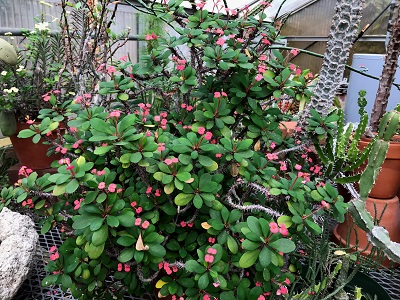
Crown of Thorns
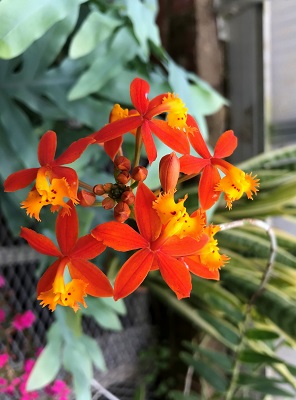
Orchid
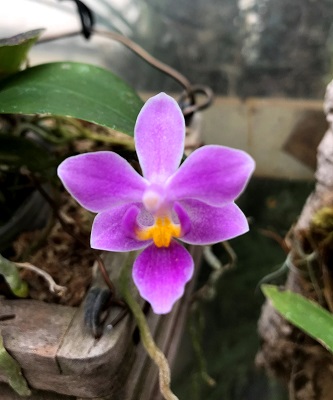
Phalaenopsis

Phalaenopsis
Laeliocattleya Gold Digger
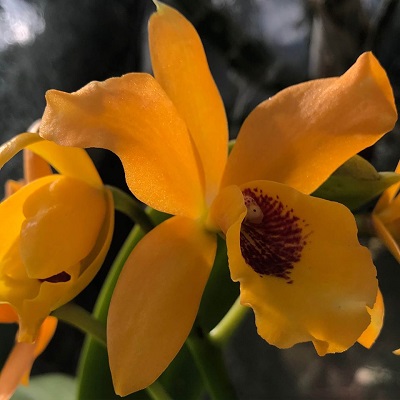
Flowers of the Laeliocattleya (syn. Cattlianthe) Gold Digger, aka "butter cup," are currently in bloom inside our Deep Cut Gardens greenhouse. Would you like to take a guided tour? Sign up for our March Green House Open House tours. (posted 2/10/2020)
First Snow Fall of the Year!
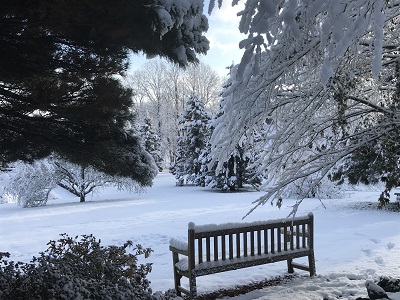
See the gardens cloaked in snow and enjoy the silvery beauty of the season. Deep Cut Gardens is open daily year round. (posted 12/3/2019)
Solandra grandiflora
Here are few photos of Solandra grandiflora also known as Cup of Gold Vine, Golden Chalice Vine, Hawaiian Lily and Yellow Chalice Vine. It is currently blooming in the greenhouse where it could be enjoyed by visitors and garden enthusiasts. Solandra plants are well known among gardeners, and are revered for their large ornamental flowers. These yellow flowers grow up to 10 inches (25 cm) long and are distinctly shaped like bells or chalices. The flowers begin as bright, brilliant white and yellow with purple or brown stripes spiraling inside. As the flower ages, the color darkens from lemon to golden yellow; hence the Cup of Gold. The flowers bloom in the evening or night and produce a strong sweet fragrance, which is similar to coconut. Chalice Vine is indigenous to the central Mexico region, yet it grows as far north as the sub-tropical regions of southern United States.
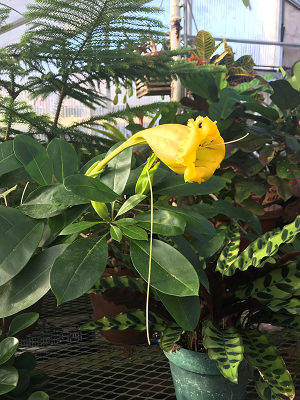
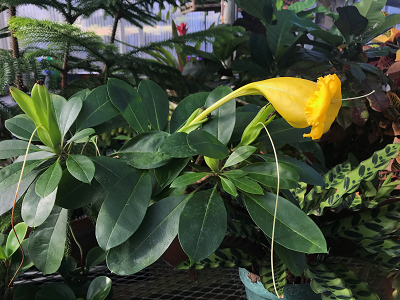
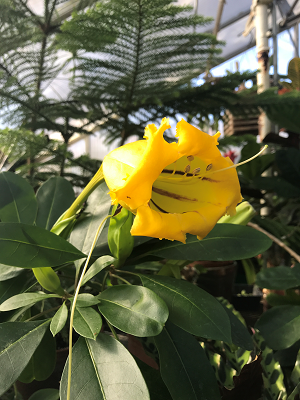
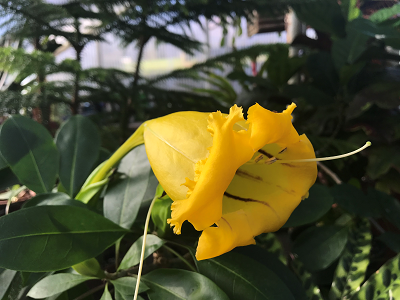
(posted 11/26/2019)
Camellia oleifera cultivar Winter's Star
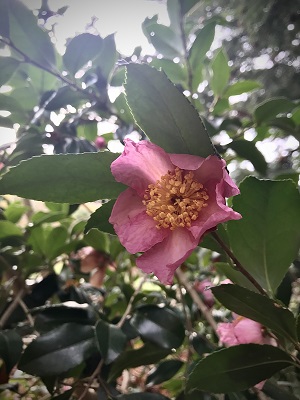
We're enjoying the last few blooms of our Winter's Star. One of the hardiest camellias, this flower can survive at -9 F. Hardy for zone 7, it blooms from October into November for up to six weeks. (Origin: China.) This plant is located along the main path to the Horticultural Center, only 10 feet from the parking lot on the left.
(posted 11/20/2019)
What was that?!
I think I saw a hummingbird! It was soooooo small! Or maybe it was a huge bumble bee. Now I’m not so sure!
While we definitely have hummingbirds and bumble bees here in Monmouth County, we also have two interesting mimics that can trick you!
There is a type of moth called a Hawk Moth, all of which belong to a family of moths called Sphingidae. These strong, fast-flying moths move in straight lines, forward or backward and therefore they look more like a bee or a hummingbird than a moth. We have two local species and, while they are common, you might mistake them as they are in disguise!
This is a Snowberry Moth (Hemaris diffinis). It has evolved to look like a Bumble Bee. The small bee waiting for the moth to move away is not a bumble bee but rather a much smaller honey bee. Snowberry Moths and Bumble Bees are about the same size.
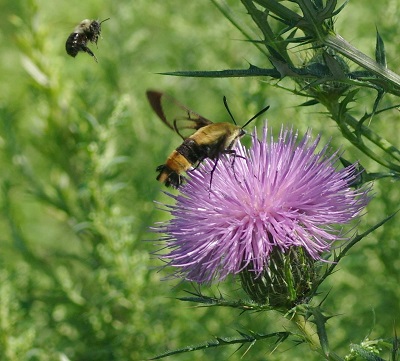
The red color on this Hawk Moth identifies it as a Hummingbird Moth (Hemaris thysbe). This moth is smaller than a hummingbird, however, it is an excellent mimic. It even flies with its tail end held up to look like the tail of a hummingbird. It also has a bunch of hairs on the tip that it can flash like a hummingbird flicking its tail. These hairs act like a rudder and help the moth maneuver in flight.
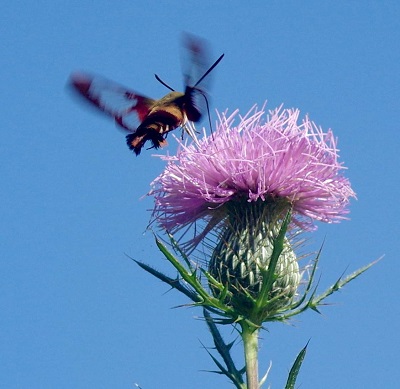
Both species have clear wings and are something referred to as Clearwing Moths. They have an incredibly rapid wing beat. The photograph above of the Hummingbird Moth was taken at 1/1000 of a second and yet the wings were still moving too quickly to catch in focus. Now that’s fast! I could not find a reference that identified the speed of a Hawk Moth wing beat.
Hawk Moths are excellent pollinators for many type of flowers. But, since they hover while sipping nectar, they are attracted to high or upright flowers that allow them to fly in, take a sip and fly out! Look for these moths in the early morning or later afternoon. You will be captivated by their antics. If you are in doubt about whether you are seeing a moth or bird/bee, look for those long antenna. Moths are the only ones of these three to have them!
And away he goes!
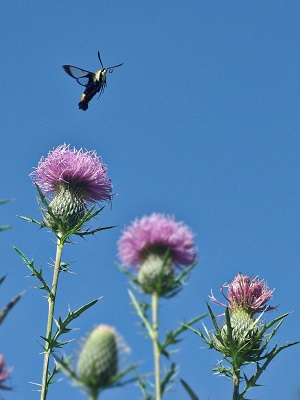
(posted 9/3/2019)
Spiderwort
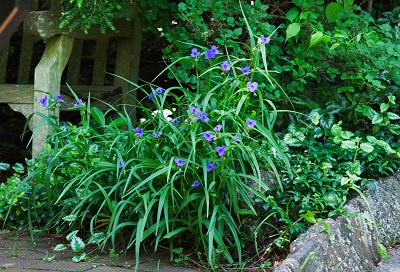
Now here is a native plant that everyone should consider for their yards. Spiderwort looks like a grass and fills the niche of linear texture as do most grasses. However, it is also a prolific bloomer! Its blooms come in a range of purples and white. It can tolerate shade through sun and it requires little care once established. This is a true Monmouth County landscaping gem! The one pictured here is on the path through the Rockery but they can also be found throughout the site.
White Elderberry
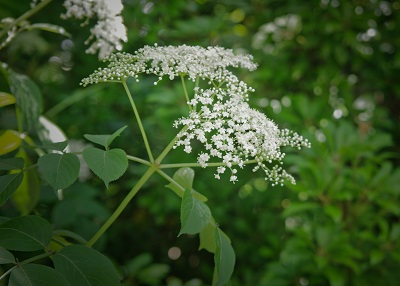
This plant grows in the shade and is something between a rangy shrub and a vine. While there are other varieties of Elderberry, this white one is blooming now on the path next to the Cottage. After it is done blooming, dark, almost black berries will arrive. These are an excellent food for birds and therefore this plant is one to consider if trying to attract wildlife to your yard.
Yarrow
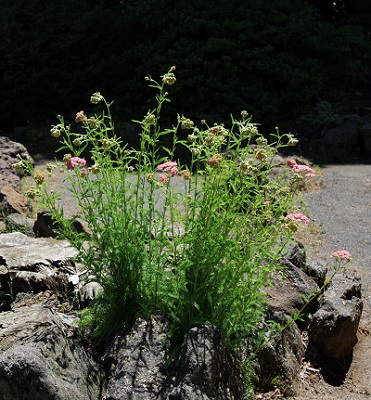
Another excellent native for Monmouth County landscapes, Yarrows are just beginning to bloom. These deer resistant plants are a must have for local gardens. Their feathery leaves are a lovely texture accent. Yarrow comes in a large variety of flower colors and they bloom throughout the summer.
Cranesbill
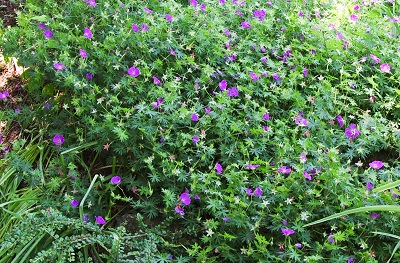
Cranesbill, also known as Hardy Geraniums as they are members of the Geranium family, are wonderful landscape plants for mass displays. Their low-growing, dense growth habit allows them to fill in in shady and partial sun spots. They have low maintenance needs and come in a variety of colors. A true keystone of the Monmouth County Garden! This big patch of Cranesbill is on the path through the Rockery below the beautiful Sargent Major Hemlocks.
Red Weeping Redbud
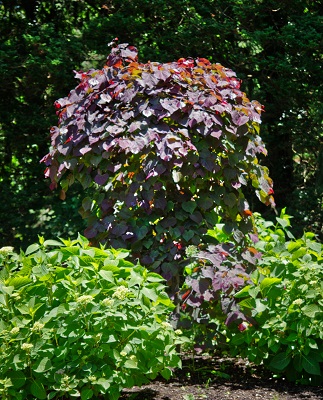
While there are many flowers to see at Deep Cut, there are also many interesting trees! This little champion is growing right outside the Horticulture Center. It is a red variety, weeping redbud tree. They are not very common and this one is truly a beauty! Redbuds in general are excellent for small yards. The variety excels in compact spaces and is a go-to tree for small space gardens.
Rose Garden
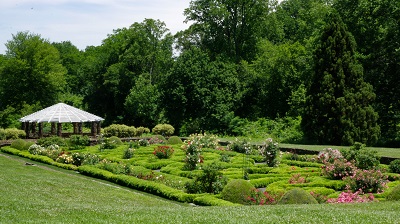
Deep Cut is known for its beautiful rose garden. With up to 72 species on site, there is a rose for everyone! This display features roses that sprawl or vine, shrub or tree, and everything in between. Some are fragrant, some colorful and they are all beautiful! Visit throughout that summer as the roses love hot weather and they will continue to shine. (posted 6/13/2019)
Clematis
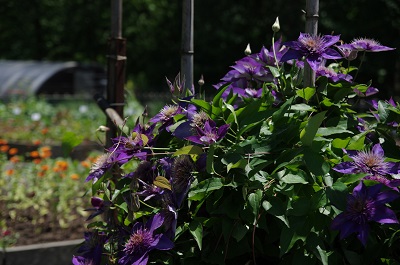
Clematis is a fabulous vine for archways and garden gates. This dark purple, large flowered variety is in full bloom in the entrance to the All-America Garden. If you look closely, you may even find one of Deep Cut fairies hanging around. Fairy Ruthie loves this plant! Make sure to pick up a Fairy and Gnome Scavenger Hunt in the mailbox at the gate of this garden. (posted 6/12/2019)
The All-America Garden is in full bloom!
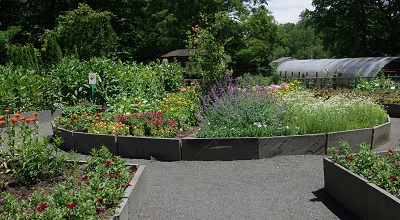
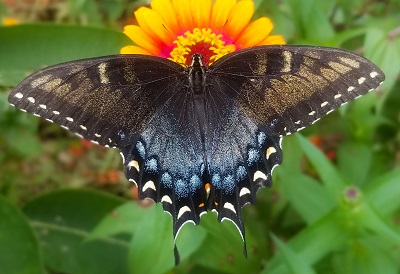
This garden is part of the All-America Selections program which tests new, never-before-sold varieties for the home gardener. After a full season of anonymous trialing by volunteer horticulture professionals like Deep Cut Gardens, only the top garden performers are given the AAS Winner award designation for their superior performance. The All American Garden is a top location for butterfly enthusiasts. Butterflies like this Black Swallowtail (NJ State Butterfly) as constant visitors. (posted 6/12/2019)
Climbing to Heaven
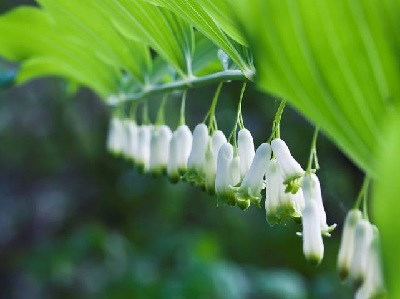
Jacob's Ladder
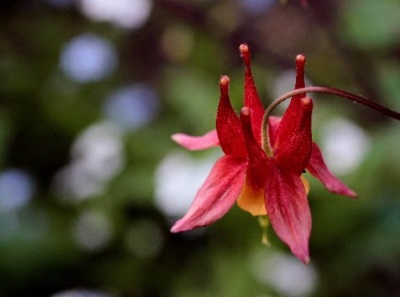
Columbine
The plant Jacob’s Ladder gets its name from the biblical story Jacob’s Ladder. The small bell-like flowers hang below each stem while the leaves all point upward. These are an example of the hidden plants that you can find at Deep Cut. These, as well as Jack in the Pulpits and other less showy plants can be found in nooks and corners throughout the garden. (posted 5/14/2019)
Dogwoods Are In Bloom
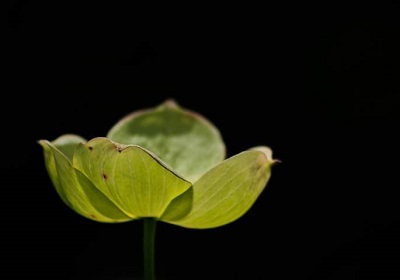
This elegant blooming tree is a beautiful sight! Some are native while others are from around the world. These beautiful flowers don’t last long so head in to Deep Cut soon to see these delicate, trees before it is too late.
Bring your camera too! The Deep Cut Gradens’ photography contest “spring” deadline is May 30th. Find out more about this competition. (posed 5/14/2019)
The Rock Walls are Alive….
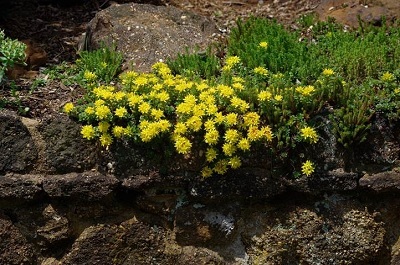
… with flowers! Deep Cut is known for its extensive rockwork. The walls, many of which have planters on top, are in bloom. Plants like this Sedum are creating quite a show! Sedum ground covers make excellent rock wall and garden plants as they are very hardy, are reliable perennials and bloom on and off throughout the season. (posted 5/14/2019)
What's in Bloom

This photo was taken on May 8 at Deep Cut Gardens. Pictured (clockwise from top): the last of the Tulips, Rhododendron (shrub with purple flowers), Andromeda (pink shrub), Azalea (red flowers) and Ajuga (purple flower in the wall). (posted 5/9/2019)
The Red Buckeye is in Bloom!
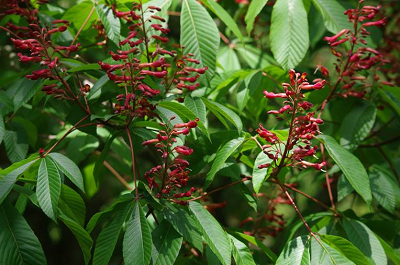
This tree has lush green leaves and large sprays of small red flowers. The flowers, shown here are mostly open. Their long tubular shape is perfect for hummingbirds. (posted 5/8/2019)
Shade Flowers!
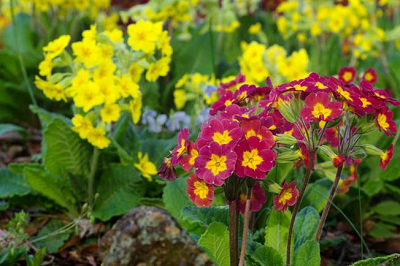
Primroses
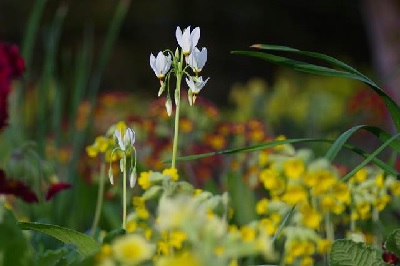
Shooting Star
The Primrose bed in front of the Greenhouse is in full bloom! These beautiful plants are one of the only types that bloom this heavily in full shade. And – the bed has a guest. Shooting Star (Dodecatheon meadia), a native North American wildflower has sprung up within the mass of Primroses. (posted 4/30/2019)
I Spot a Spotted Violet
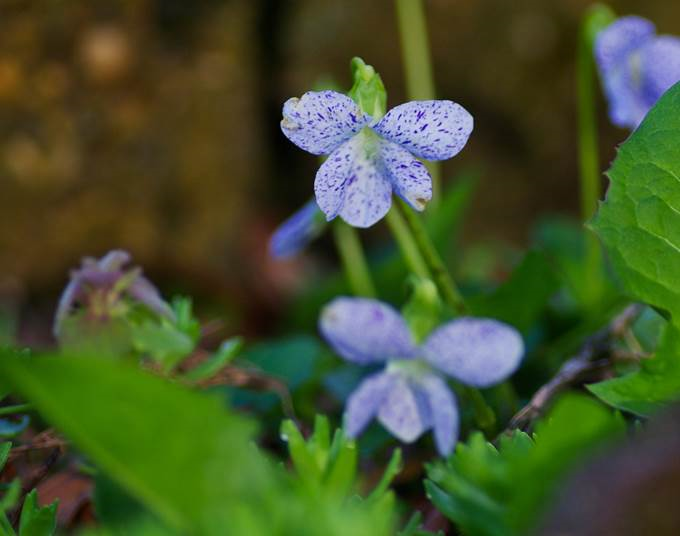
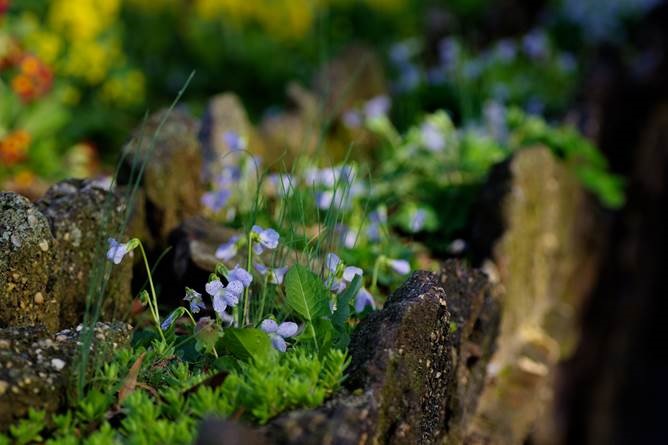
All along the top of the wall around the greenhouse, an interesting variety of our common meadow violet variety “freckles” is blooming. It has spots! The wall is coming to life with sedum, ajuga and other beauties along with these delicate violets. (posted 4/29/2019)
Bulbs Are Still Blooming at Deep Cut
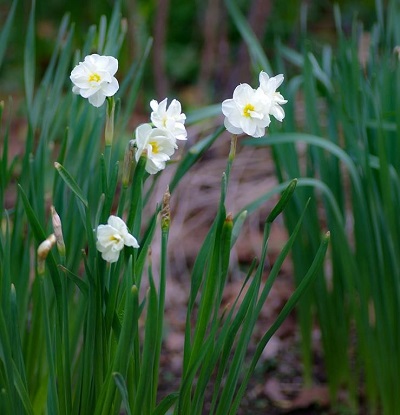
There are still lots of spring bulbs making a show at Deep Cut Gardens. There are many daffodils in bloom including these ‘double daffs’. Look for these between the Cottage and the Horticulture Center. (posted 4/26/2019)
THE TULIPS ARE STILL IN BLOOM!
Some are a little ragged from the wind we’ve had but they are still beautiful. (posted 4/24/2019)
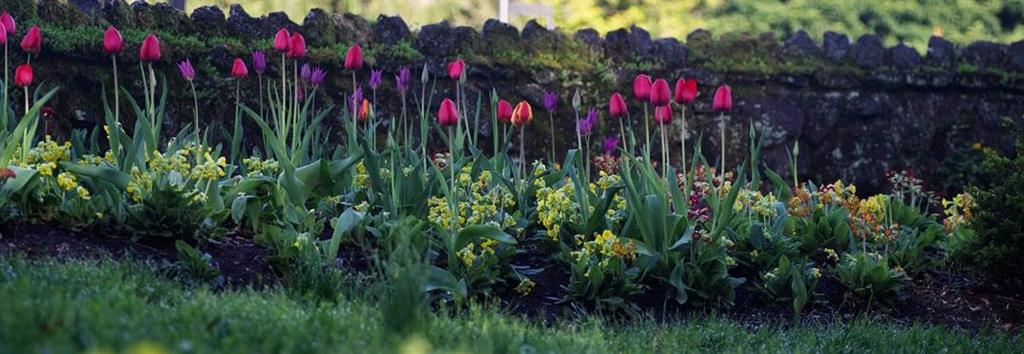
Flying Dragon in the Garden?
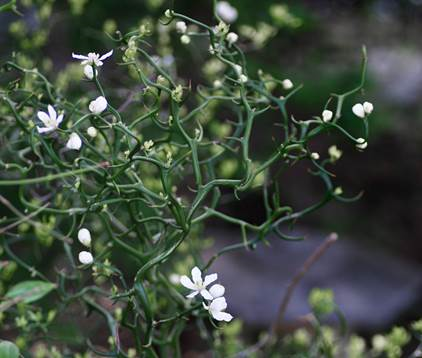
Actually… yes! Flying Dragon (Poncrirus trifoliate), also called Hardy Orange, is a citrus relative that is a sight to behold. It is a twisted thorny plants that grows to about 15’ tall. Ours is just leafing out and it is in bloom! The fragrant flowers are typical ‘citrus’ blooms and, if pollenated, will produce small lemony-flavored fruit. Look for it in the Japanese Miniature Garden between the greenhouse and the cottage. (posted 4/23/2019)
What is Blooming Now?
When I saw the Witch-hazel in bloom, I remembered that I wrote a note about this plant last year. Interestingly, when we found that post, I noticed the time difference. Last year this tree was blooming in mid-January and this year, late February. I’d love to say that I know what this is but I don’t! Then I looked for the Heleboris also noted in the original article and those too are just in bud now. It seems our winter bloomers are running late this year. The information about these two great plants is appropriate now and I hope you enjoy learning about two of my favorite plants.
The witch-hazels are small trees or shrubs. They lose their leaves in the winter but they bloom instead. When it comes to flowers, there are big showy flowers and less showy flowers. Then there are witch-hazel flowers. The yellow petals are long, narrow and yellow and grow out of a dark red center. They hang down from the branches creating a very wispy, delicate look. The name witch-hazel is misleading as it has nothing to do with witches. It derives from the word “wiche”, an old English word for bendable and/or plant. As for uses, these are the branches that were used for diving rods in England. The leaves and bark of the North American variety are the source of the astringent we commonly call witch nazel.

Now if showy flowers are more your style, heleboris are your winter go to plant. These fantastic plants are evergreen, deer resistant and have wonderful speckled leaves for year-round interest. Then, in the winter, they produce many flowers in low clusters among the leaves. Varieties range from pale pink to burgundy. These are a staple for shade gardens in this area.

(originally posted 1/19/2018)
Uh Oh – Are Those My Bulbs Up Already?
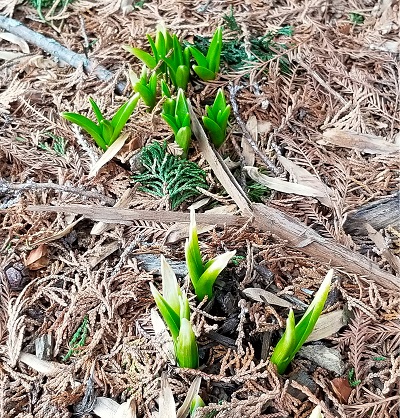
Don’t worry it you see that your bulbs have popped. Even though we can have snow into April, bulbs are well-adapted to cold weather. The tips of the new leaves will likely turn yellow or even die back but the plant will recover. While it may seem logical to mulch over these bulbs to help keep them warm, you don’t want to cover the new leaves. The plant is awake (no longer dormant) if it is able to produce leaves and that means it is hungry. Those new green leaves are rapidly making food and sending it into the bulb so that it can be ready to flower in early spring. Covering it now would be more harmful than if the leaves became frost damaged. If it looks like we will get consecutive nights in the in the mid to upper twenty degree range, you can cover the bed with a sheet and remove it during the daytime. This will just prevent ice from forming directly on the plants. Remember – spring bulbs have evolved to be active at this transition time and they are well-adapted to the irregular temperatures. (posted 2/21/2019)
Where the Plants Are Still Green…..
This column is titled “In the Garden” but right now we are all “in the house.” Luckily, there are green things to love inside with us! Most indoor plants have slowed down for the winter but they are not dormant. Winter is the perfect time to do a little bonding with your indoor plants.
When you have a time, visit with your indoor plants. Really look at them. How are their leaves and stems? If there are dead or damaged leaves, cut them off. A good clean-up will drastically improve the look of your plants as well as take away food for fungi and other pests.
Speaking of pests, are there mealybugs present? They will look like little cotton fuzzies and will be a little sticky. These insects are very common winter pests and, if you have them, you need to treat the plant right away. Mealybugs are contagious and rapidly move to other plants. You can treat your plant with an insecticidal soap which dry out the insect. You will need to do this a few times in order to kill newly hatched individuals. While insecticidal soaps are very mild but you should always read the label before applying.
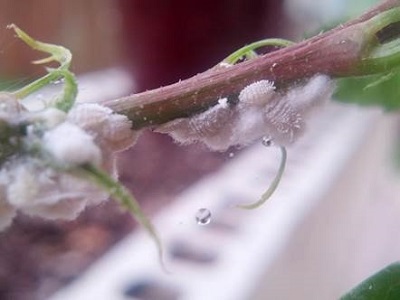 A cluster of mealybugs on the stem of a houseplant.
A cluster of mealybugs on the stem of a houseplant.
If you are still fertilizing your indoor plants, cut back to quarter strength with every other watering. Plants that are somewhat sleepy in the winter can get salt damage on their roots if over fertilized. Even those plants that are wide awake will benefit from a little less fertilizer during this season. (Posted 1/25/2019)
An Indoor Plant to Try: Begonia
If you want to buy a plant to replenish your collection of indoor plants, try a begonia. There are many varieties to choose from and they do well indoors. They bloom in winter making them a treat during these cold months. Begonias have an interesting trait to check out. Most plants throughout the world are both male and female as each of their flowers have both male and female parts. Individual begonias are also male and female, but instead of having a single flower with both parts, they produce two different flowers on the same plant. If you look closely, some flowers will have a single, large sturdy part, in the center of the petals (female flowers) while others will have a clump of small, delicate structures instead (male flowers).
This photo shows two male flowers above a single female one:
Male and female flowers on a single begonia plant.
The begonias in Deep Cut’s greenhouse are in bloom as are many of the other tropical plants. (Posted 1/25/2019)
Not Just for Pretty’s Sake!
Bunch and fountain grasses are one of the most beautiful centerpiece plants to have in the garden. All summer they provide wispy texture and straight lines that enhance the overall aesthetic of your landscape design. Then winter rolls around and what once looked like this:
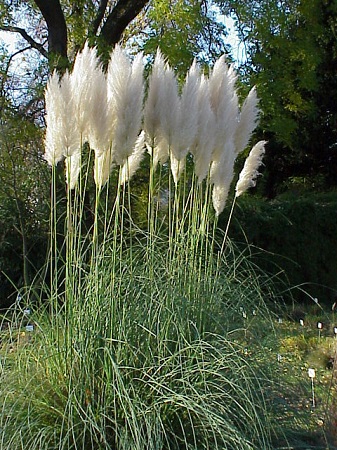
(Wikicommons)
Now looks like this:
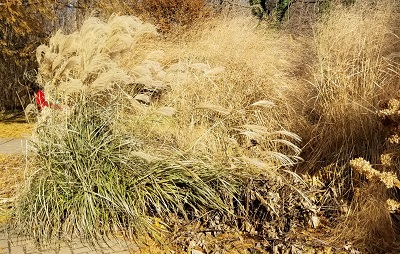
While the appearance of the winter grass might be a an issue for us, it is an even bigger issue for the grass. If we cut off the top of the plant to ‘clean it up’, the base of the plant is exposed and may freeze in the winter. The other option, to leave it alone, also has problems as the sagging leaves and stalks create a sort of tent and underneath this may remain damp for extended periods, promoting rot. Often, the long sagging leaves cover nearby perennials causing them to suffer as well.
What to do? Lift the plant up! In my yard I create “ponytails” with my grasses and tie a ribbon around them for a little holiday spirit. You could also just tie them up with string. Doing this provides insulation to the base of the plant while allowing air to flow beneath the plant, preventing rot. A win all around!
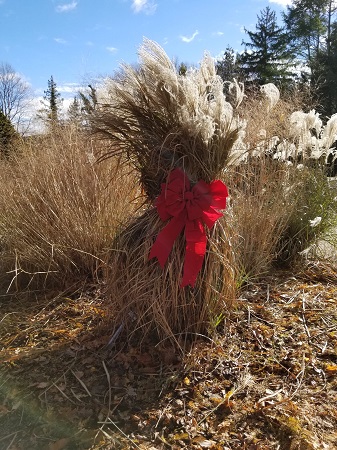
(posted 11/28/2018)
A Wish List Makes Wishes Come True!
Do you know that yard in your neighborhood that even has interesting plants in the winter? If you are like me, you drive by and think “I wish my yard had even a few of those interesting plants!” The trouble we all have, however, is that nurseries aren’t open now as it is the wrong time to plant. Therefore, when you are thinking about plants for your winter garden, none are actually available to purchase. Then the winter ends and we are on to our spring and summer plantings…. until the next December when we repeat this cycle.
Here is a strategy that you can start now – create a Winter Plant Wish List! I know this sounds silly but it will help you shop during the summer for your winter landscape. All you need to do this winter is get out your phone and take a photo of a plant you like when you see it. In the spring you will bring the phone/photos to Deep Cut or a garden center to find out what the plants are and about their care needs. The plants will usually have spring and summer purposes with the added bonus of winter interest!
This morning I was walking into Deep Cut and noticed that one of my “Rock Star” plants is a great example of how this strategy works. A few years ago I saw a beautiful evergreen, leafy ground cover peeking through the snow in February. It had purple leaves and a pretty shape. I took its picture and was able to identify it as Ajuga. Ajuga is on my Rock Star Plants list because 1) it thrives in full shade, 2) it is a ground cover that blooms well in the spring, 3) deer don’t usually eat it and 4) it is an evergreen. Win-Win-Win-Win! Once spring arrived that year, I purchased some Ajuga and now I have a lovely patch in my yard.
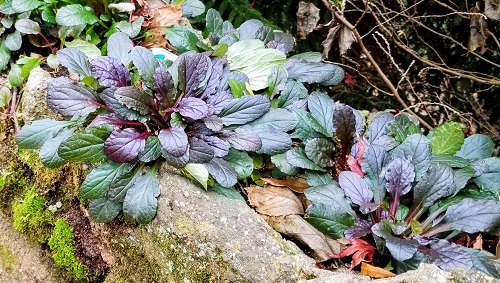
Ajuga in winter
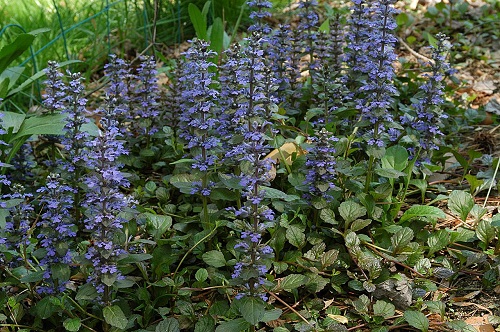
Ajuga in spring
Give creating a Winter Plant Wish List a try and next year your yard will be the one prompting wishes! And, as always, the staff and volunteers at Deep Cut are here to help if you need it! (posted 11/15/2018)
Can Fog Hurt My Plants?
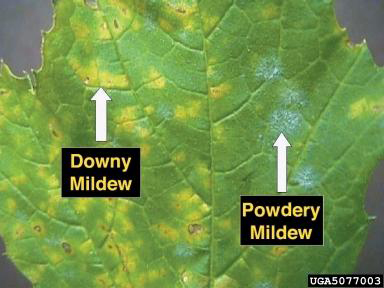
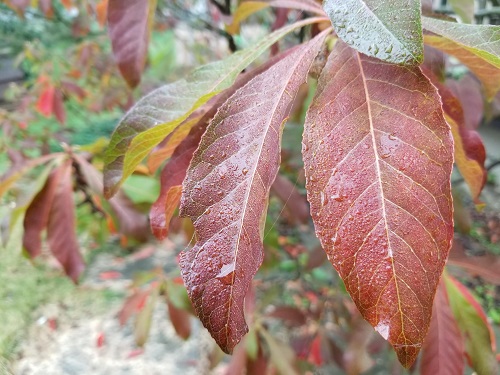
Actually – yes. During this season when the night air cools but the ground is still warm, it is common to have dense fog in the mornings. You might think that this gives plants a respite from sun and a nice drink, and while true, extended foggy spells spell trouble in Zone 5. Plants breath out through their leaves which draws water up from the roots. They do this by opening pores on the leaves and letting gasses and water evaporate out. However, when the air is too moist, such as when it is foggy, the process stalls with the lack of evaporation. Most plants can tolerate this for a morning, particularly if the fog burns off and the sun comes out. This pattern can go on for a while without harming the plant. Extended foggy mornings with humid, overcast days may be a problem though. And, while the pores on the leaves are open as the plant tries to breath, fungi are on the prowl. They can enter the plant through the pores and cause rot.
Bottom line? If we have fog for 4 or 5 days and the sun doesn’t come out for a few hours each day, check your plants for rot. This may show itself as soft, squishy leaves, ‘powder’ (fungal spores) that is white or black on the leaf top or bottom, or as a black, soft ring at the base of stems. If you find this, you can prune off the effected parts. Most plants are going dormant now so this may not hurt the plant permanently. However, if you see anything ‘powdery’ – white or black – on the leaves you may want to treat with a fungicide. (posted 10/10/2018)
Who’s Looking at Me? A Silver-spotted Skipper Caterpillar!
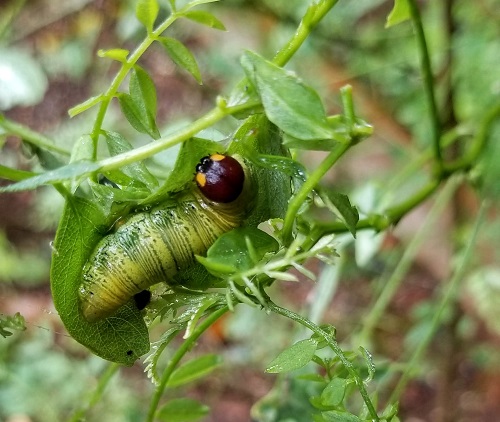
Silver-spotted Skippers are a true ugly duckling story. Like all butterflies, they start their lives as a caterpillar. Their caterpillars aren’t quite as pretty as some others though. Actually, they can even be a little scary! These interesting insects are members of the skipper family. This means that they generally have short wings that they hold folded back when landed. Silver-spotted skippers are brown with a white ‘blob’ on the underside of their bottom wing. Then there are their caterpillars. These ferocious, but harmless caterpillars are short and plump with a large brown head. The head has big yellow eye spots above their actual eyes. They use these to startle predators into thinking that they are dangerous. The caterpillar spends its day rolled in the leaf of a legume such as a locust tree and points its eyespots out the opening. Anything that comes by will think twice about investigating! (posted 9/28/2018)
There’s Nothing Common about the Common Toad Lily!
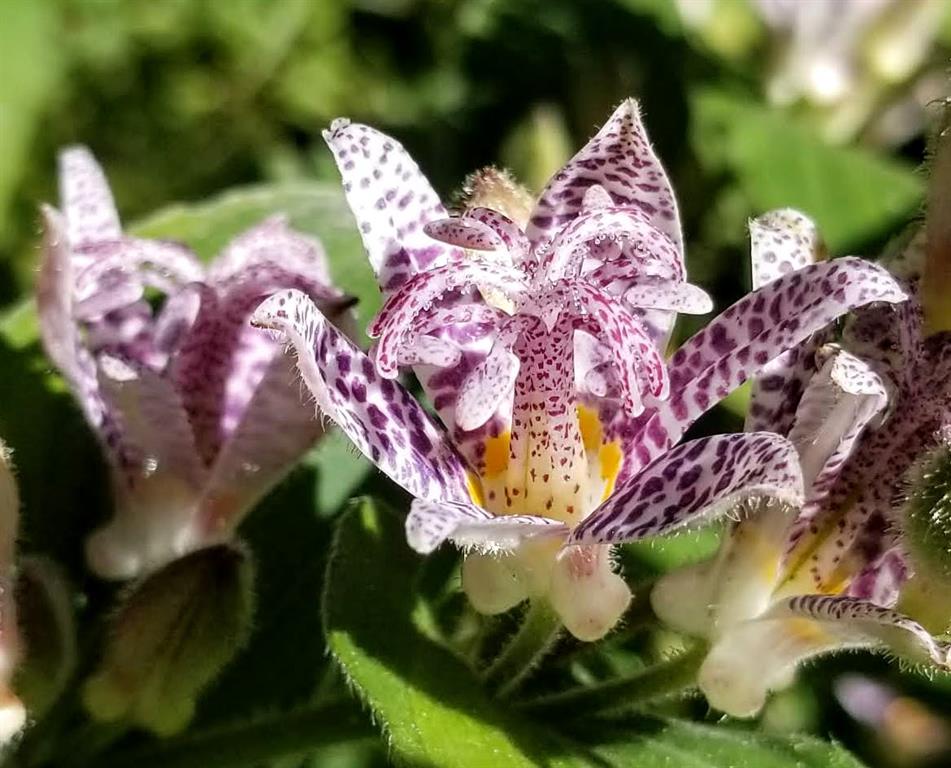
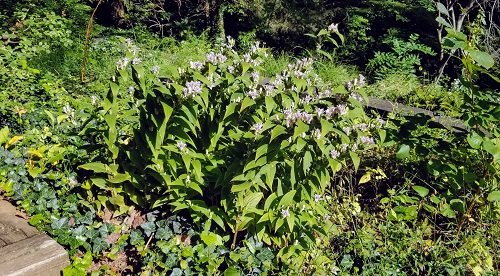
What a great surprise to step out of the back door of the display greenhouse and see a blooming common toad lily. This beautiful, shade-loving plant has amazing, exotic looking flowers that bloom at the end of summer when many plants are going dormant. The plant itself is also lovely and has a nice arching shape that adds a nice touch to the garden. They need little maintenance but they do like moist, well drained soils. That shady corner of the house near the downspout would be ideal for this beauty! In nature they are understory woodland plants, so morning sun to mostly shade is preferable. (posted 9/27/2018)
Divide and Share!
In honor of this weekend’s Great Spring Plant Swap, here is information about dividing your perennials. Enjoy!
When to Divide: Now is a great time to divide most perennials. They are awake and starting to grow but they aren’t in full leaf. This helps ensure that they are awake enough to heal the cut from the division while not having so many leaves that they wilt before rooting. If you are not sure if your plant prefers dividing at a different time of year, give a call to Deep Cut to speak with a horticulturist or come by the library in the Horticulture Center.
Where to Dig: Insert you shovel at the outer edge of the leaves called the ‘drip line’ – not at the base of stem. You need to get a chunk of roots in order to give the plant a chance to reestablish before it wilts. Dig straight down a little before angling beneath the plant and prying it up. Dig on all sides of the plant rather than trying to pull it out after digging only one side. If you are only trying to reduce the plant’s size, cut off a portion of the plant and leave the remaining portion with its roots attached. If you are removing or relocating the plant, remove the entire plant, divide it and then replant where desired.
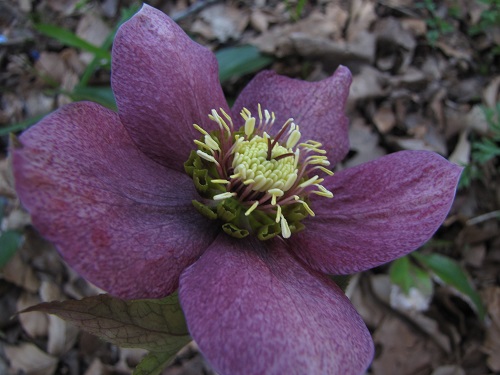
Heleboris
How to Divide the Plant: You can use a couple of methods to divide the plant. For each plant, start with the least severe method first: Your hands. Try to pry apart they plant. Examples of plants that divide well by hand are bleeding hearts, coral bells, cranesbill, hellebores, pulmonaria and yarrow. If the plant is firmly attached and requires cutting, place a spade on the crown where you would like to separate the plant and quickly and firmly chop down, severing the rhizomes that are connecting the plant underground. Plants that can be divided in this manner include black-eyed susan, catmint, coneflower, daylilies, grasses, hostas and ferns. If the plant is too woody to separate easily with one cut of the spade, don’t hack at the roots. Rather, use a fine-toothed saw to divide the roots. Plants that do well using this method include astilbes, caladium, meadowsweet, rhubarb and irises.
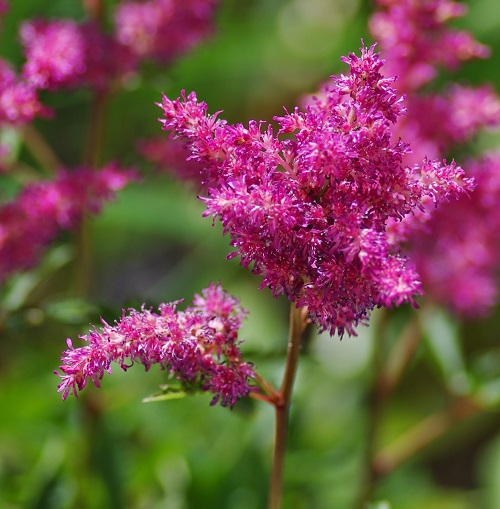
Astilbe
Caring for the Divided Plant: The plant needs a period of time to heal any wounds on the roots prior to planting in soil in order to avoid infection. However, during this healing time, the top of the plant still needs water. Trim some of the plant’s top back as this helps prevent wilting. Regardless, place the plant between sheets of wet newspaper to keep it damp and cool or place the roots into a bucket of water and place in the shade. When replanting, cover the plant with a white sheet or landscape screen and water heavily. Remove the shade screen when the top of the plant perks up indicating that the roots are taking up water.
Are there Plants the I Shouldn’t Divide? Yes. Just a few examples are alyssum, candytuft, euphorbia, foxglove, geranium, lavender, Russian sage and rosemary.
This is just a brief note about dividing. If you are new to this practice, always do a little research first. At Deep Cut, we are here to help too! Now, divide some of those large perennials and come to the Great Spring Plant Swap on Saturday, April 21. Details about the swap as well as instructions can be found our Deep Cut Garden webpage. (posted 4/16/2018)
Are Bulbs Coming Up Too Early?
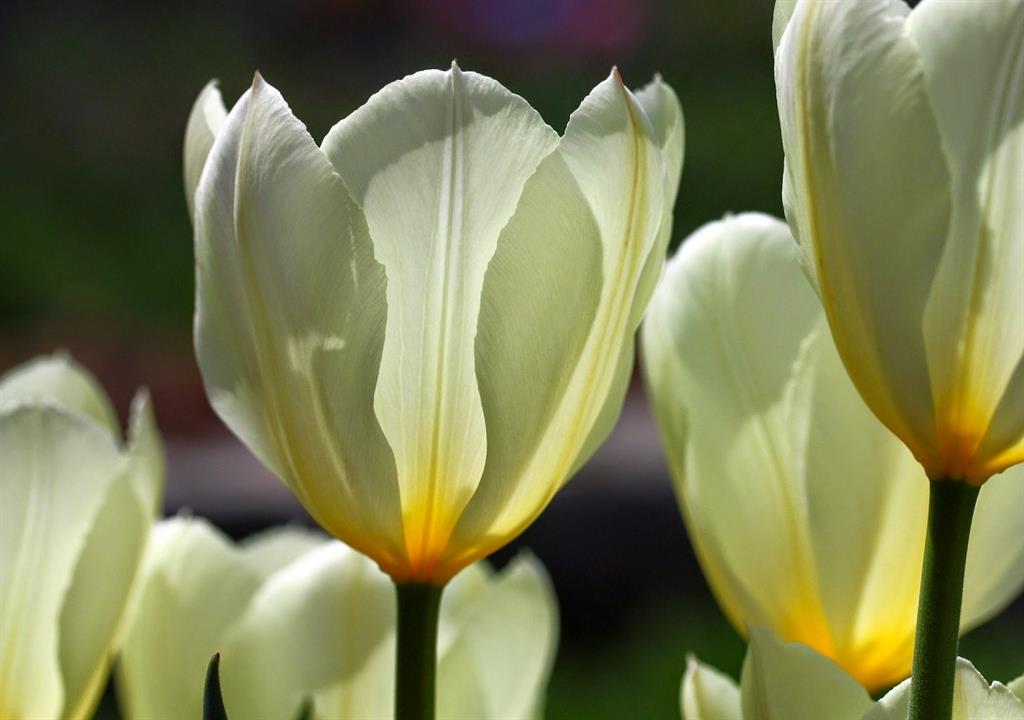
You have probably noticed that many of your bulbs have sprouted. I have even seen a few daffodils in bloom! This time of year is always tricky as March, and even early April, can still see snow and cold temperatures. The leaves of most bulbs are adapted to this season and should be fine. If we get a significant cold snap, the leaf tips may turn yellow or even brown but the plant will recover. If you can see the tops of the bulb itself poking above the soil, you could mulch the bed to provide some insulation but don’t cover the new leaves entirely. Some early bulbs, such as Snow Drops, are in full bloom and won’t be effected by the weather. Crocuses are next up and they should be fine as well. If your typical spring bulbs, such as tulips and daffodils, produce buds and temps are below freezing, the buds may appear to wilt. Leave them on the plant. They may come back or they may not. If they don’t, the plant will likely produce another. If it looks like we will get an extended cold snap and your bulbs have buds, you can cover them at night. However, the beauty of early spring bulb is that they have evolved to thrive in this variable, inconsistent transition season. (posted 3/15/2018)
The Sun is Out – I Wish I Could Garden!
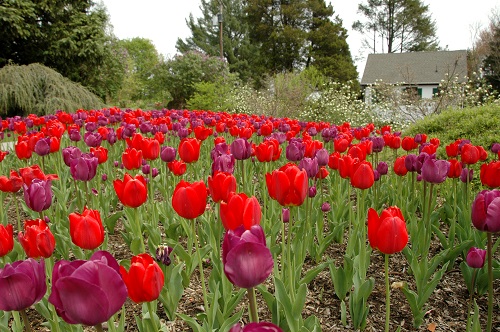
As we wait for this year's tulips, here's a look back at some spectacular ones.
There is something you can do now that will improve the success of your spring bulbs and can sooth your inner gardener at the same time. If you are storing bulbs for planting in the spring, now is a good time to check up on them. As they sit the winter away in your basement or garage, there is a chance they could be developing issues that you could stop before you suffer a greater loss. Most bulbs are healthy enough to last through the winter unscathed. However, one unhealthy bulb that can’t fight off fungus can spread disease to your entire batch. Nothing is worse than opening the bag or box of stored bulbs in the spring only to find a furry fungus mess! Here are a few suggestions for a winter check up:
-
Unpack your bulbs and take a good look at them.
-
Throw away any that are rotten or moldy.
-
Replace packing material that is damp or moldy.
-
If you have a few bad bulbs and it looks like the fungus may be spreading, treat the remaining bulbs with a fungicidal dust which can be purchased at any garden center. Follow the product’s directions.
-
Repack the bulbs, ensuring good airflow and keep the bulbs from touching, if possible.
-
Keep the bulbs between 40°F and 50°F.
Completing this task significantly raises your success rate for overwintering bulbs. Now you can go back to dreaming about spring! (posted 1/15/2018)
What is Blooming Now?
I bet you didn’t expect to see this topic in January! There are some plants that will start blooming now, or will start soon. I always feel that winter flowers are a gift.
The witch-hazels are small trees or shrubs. They lose their leaves in the winter but they bloom instead. When it comes to flowers, there are big showy flowers and less showy flowers. Then there are witch-hazel flowers. The yellow petals are long, narrow and yellow and grow out of a dark red center. They hang down from the branches creating a very wispy, delicate look. The name witch-hazel is misleading as it has nothing to do with witches. It derives from the word “wiche”, an old English word for bendable and/or plant. As for uses, these are the branches that were used for diving rods in England. The leaves and bark of the North American variety are the source of the astringent we commonly call witch nazel.
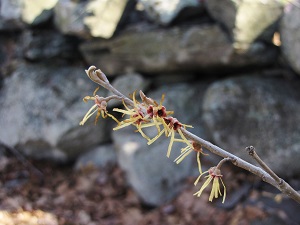
Now if showy flowers are more your style, heleboris are your winter go to plant. These fantastic plants are evergreen, deer resistant and have wonderful speckled leaves for year-round interest. Then, in the winter, they produce many flowers in low clusters among the leaves. Varieties range from pale pink to burgundy. These are a staple for shade gardens in this area.
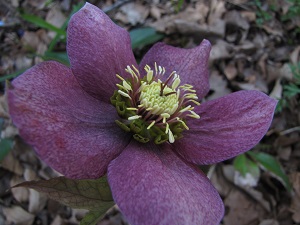
(posted 1/19/2018)
See What's Blooming in the Greenhouse
While the outside gardens at Deep Cut are covered with snow, the greenhouse is warm and blooming. Stop by for a little reminder of warm weather and beautiful flowers! Here are a few things to see that are blooming now:
Bromeliads – These plants, which normally grow attached to trees in the tropics, have colorful leaves and unusual flowers.
Orchids – These lovely plants have flowers with such strange coloring and shapes! The variety is amazing.
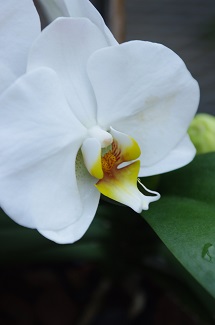

Hibiscus – The big blooms of hibiscus range in colors from deep red to sunset-like oranges and yellows.

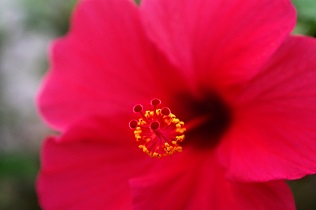
Begonias – While most plants have flowers that have both male and female parts, begonia flowers are either male OR female. These delicate flowers are held high on branched stalks and, while small, are very pretty.
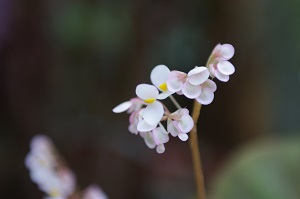
Kalanchoe – These hardy plants are very sturdy and yet get the most delicate, beautiful, tiny blooms!
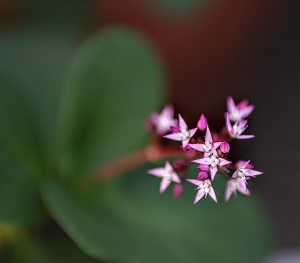
If photography is a passion of yours, check out Flower Marco Photography coming up on January 27. It is a full-day class in the greenhouse where you will learn to capture the images of these beautiful flowers and more. Register online or call 732-842-4000 ext. 1 or register online. Space is limited.
Aerial Roots
While in Deep Cut Gardens this past weekend, a visitor asked about the roots that grow out of the pots on some of the plants in the greenhouse. The roots in the below photos are a type of aerial root that develops when a climbing plant needs stabilization. There are other types of aerial roots that develop for other purposes. Vines and epiphytes (plants that grow on trees such as orchids) can become top heavy and fall over if they don’t grow aerial roots for anchorage. There are even trees such as banyan trees, which grow in soggy soil, that grow aerial roots for stabilization. Aerial roots are not actually root tissue but are rather a stem adaptation. Because of this, they can sprout true roots and stems which can be separated into a new plant.
Many people whose houseplants begin producing aerial roots wonder if these roots should be removed. Even thought they might become quite long and/or dense, the answer to “trim or not to trim?” is usually not to trim. If you prune aerial roots, they may branch. Therefore, if you must cut these roots, do so in the fall when the plant’s growth is slowing. If you prune aerial roots in the spring or summer you may find yourself with many more roots than you started with! If your plant is growing aerial roots onto the wall, bookcase or other unwanted place, consider putting in something for the plant to climb on like a stake or other structure designed for this purpose. I like the look of aerial roots as, to me, they mean that the plant is growing normally and is happy.
These roots on the below philodendron may look like they are strangling the plant but they are not. The plant is actually anchoring to itself. This may work for a while but as the plant becomes taller, it will need something else to provide support.
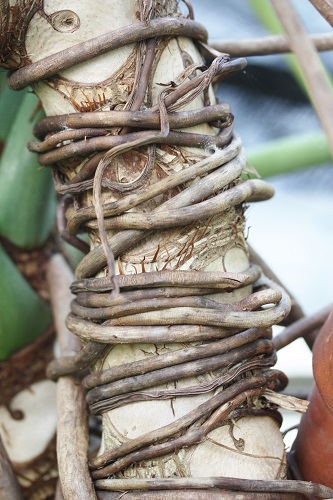
philodendron anchoring upon itself
Aerial roots are common on orchids such as the one below. Healthy roots should be left alone as pruning them can have a negative impact on the plant. Dead, dry roots may be trimmed. The roots in the below photo are healthy, firm and green. Dead roots from the left side of the pot have been removed.
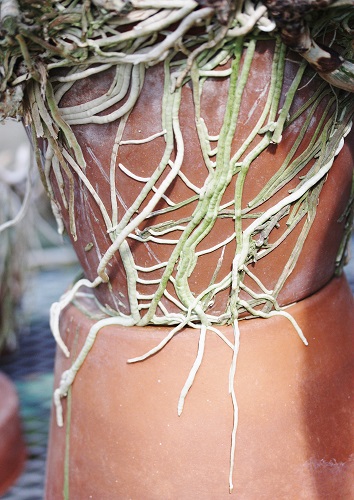
aerial roots on orchid
(posted 9/28/2017)
Fast Little Flyers – Skippers!
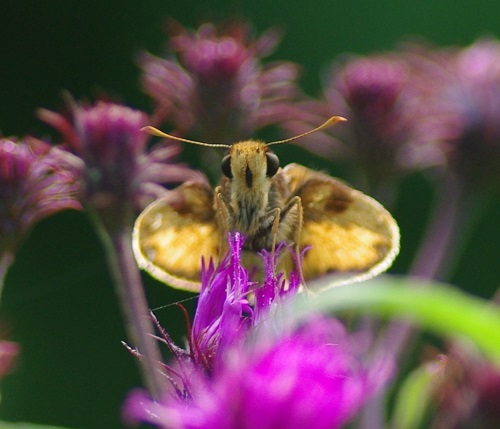
zabulon skipper
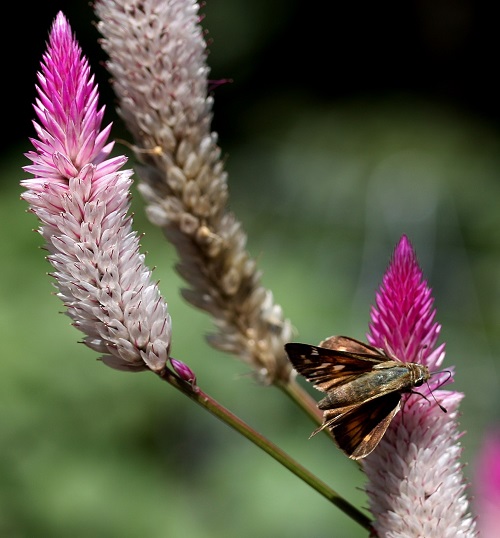
hobomok skipper
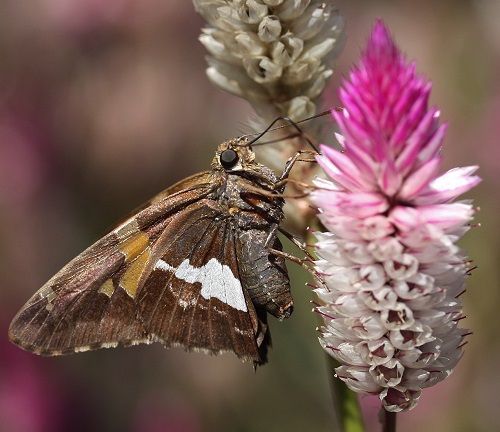
silver-spotted skipper
This time of year brings a plethora of tiny, fast-flying butterflies called skippers. For budding photographers, they are one of the easiest of the butterflies to photograph as they are not easily spooked and they sit still while eating. Skippers make up an entire family of butterfly called the Hesperiidae and can be identified by a few key characteristics. Skippers get their name due to their rapid flight as they go from flower to flower. They are able to fly this way because they have powerful wing muscles, making their bodies look bulky and large compared to their wings. Their wings are short and blunt, while typical butterflies have large wings compared to their bodies. Skippers usually rest with their wings folded back or closed tightly above their backs while other butterflies usually rest with their wings laying out to the sides. Skippers have large eyes and are thought to have good vision and their antennae have a bulb at the tip that ends in a point (visible in top photo). Lastly, skippers are usually drab colors, mostly brown or golden. The three skippers here are common in this area: zabulon skipper (top photo), hobomok skipper (middle photo) and the silver-spotted skipper (bottom photo). Grab your camera or cell phone and take a photo of one of these fellows – you’ll probably get a great shot! (posted 9/13/2017)
Good Guys That Look Bad!
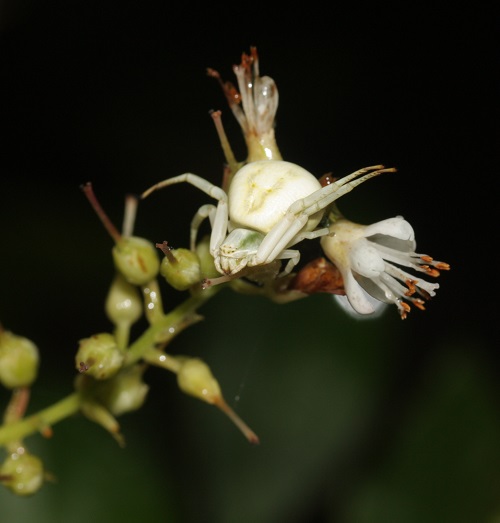
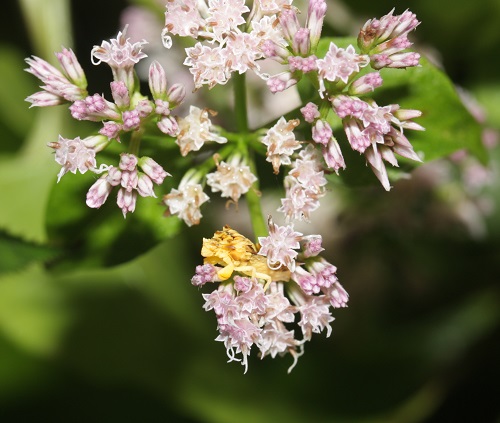
(l to r) goldenrod crab spider & jagged assassin bug
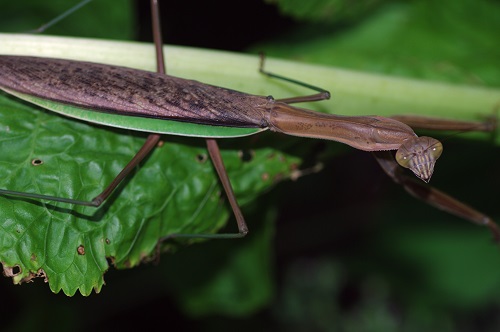
Chinese mantis
Most gardeners know that there are good bugs and bad bugs for the garden. When we think of "good bugs" we usually think of pollinators like bees and butterflies. There are, however, also predators that help keep the plant-eating insect population under control. Three of these are featured here. All are sit-and-wait predators that use their front legs to grab passing insects. They each have a special appearance that allows them to go unseen until it is too late! The jagged assassin bug (Phymata sp.) is very tiny and looks a piece of a leaf stuck on a flower – until it reaches out with its raptor-like arms and catches its dinner. The goldenrod crab spider (Misumena vatia) is one of a very few insects that can actually change color to match the flower it is sitting on, remaining almost invisible to other insects. Lastly, even though the Chinese mantis (Tenodera sinensis), accidently introduced to the US in 1896, is the largest mantis in North America, it can be easily missed as is sits very still and looks like a piece of a plant. If you think of plant-munching insects as "stealing" your garden treasure, these three insects champions are the law enforcers that will catch the thieves in the act! (posted 9/7/2017)
Every garden needs a garden spider.
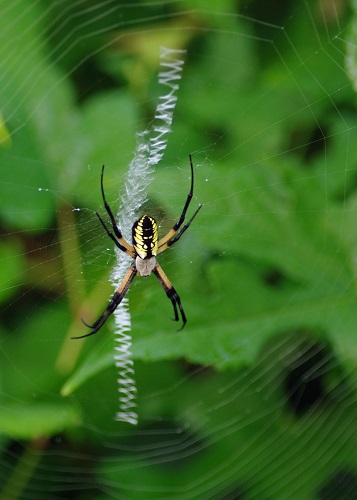
Seeing a yellow garden spider (Argiope aurantia) might give you quite a start but it is good thing to have one of these garden dwellers in residence as they eat a considerable number of insects each day. Aside from their striking coloration, yellow garden spiders can be identified by their unusual web, which is built in open areas and has a large zig zag of concentrated webbing in the center. This webwork prompted their other common names - zipper spiders and scribblers. It's thought the creating this easily noticed structure in center of the web helps birds and larger animals see the web and avoid it. Yellow garden spiders are fairly docile and rarely bite – even if you walk into the web! If bitten, the reaction is similar to a bee sting. It's vital to all web-making spiders that the web be as intact as possible. The spider judges the location of prey based on the vibrations of the web. Females also identify a possible mate if he “sounds” right by plucking the web in a particular rhythm as he approaches. If the web becomes damaged, the spider eats it and then spins a new one. If you don’t consider these large spiders a welcome addition to your garden, remember that the most famous spider of all, Charlotte, was a scribbler spider. Maybe your spider will leave you messages if you let them stay! (posted 8/31/2017)
Goldflame Honeysuckle
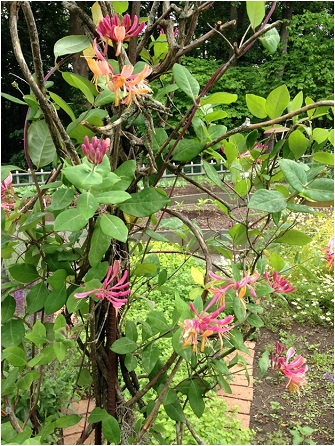
While we watch the sky for fireworks this month, it’s the goldflame honeysuckle that brings a profusion of bright color and summer sweetness to the garden. A tall centerpiece in our herb garden, the goldflame is a deciduous twining vine with hot pink tubular flowers that open to reveal a yellow center. This cross between native (or trumpet) honeysuckle and American honeysuckle is a non-invasive variety (although growth can be rampant). Fragrant, easy to grow, adaptable to most soils, and tolerant of difficult growing sites, goldflame blooms spring through fall. It prefers full sun to part shade in Zones 5 though 9. It also attracts butterflies and hummingbirds! (posted 7/11/2017)
Double Delight
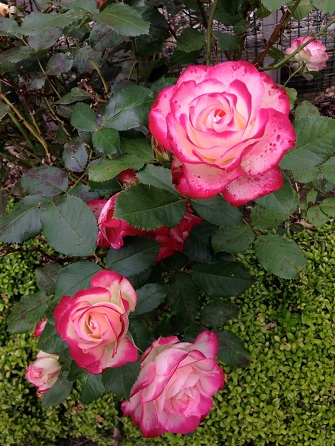
In June, the roses in our parterre are at their most glorious! And while it’s difficult to choose a favorite among them, we’re highlighting a rose that instantly grabs our attention. Growing along the border of our All-America selection garden, the double delight is a hybrid tea rose that features a profusion of vivid red and white. In bloom from late spring to early summer, the double delight grows to about four feet high and three feet wide. Hybridized by H.C. Swim for the wholesale rose grower Weeks Roses, double delight received All-America Rose Selections (AARS) honors in 1977 and remains popular today for its disease resistance and six inch wide blooms. It prefers medium moisture in slightly acidic soil with full sun. Appropriate for Zones 5 through 9. (posted 6/20/2017)
Sweet Box
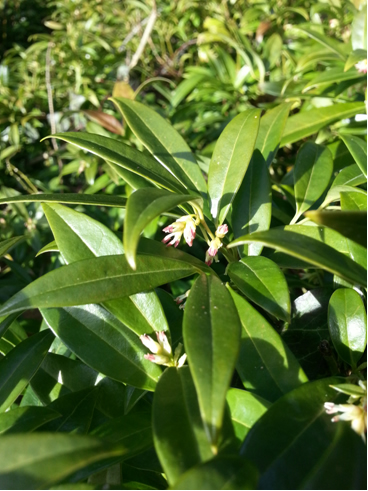
Sarcococca
Native region: Western Himalayas and China
This is the time of year when visitors come into the Horticultural Center inquiring about the source of the delightful fragrance along one of our paths. It isn’t the drifts of snowdrops, nor the nodding hellebore blossoms nor witch hazel flowers above. It is the tiny flowers of Sweet Box growing in the woodland garden below. Though the flowers may be concealed by the lustrous, evergreen foliage, the scent can travel for several feet.
This member of the boxwood family is best grown in woodland conditions: organically rich, acidic, moist, well-drained soil in part to full shade. Winter hardy in zones 6-8, it reaches only 1-2’ in height, spreads very slowly by stolons to 2-4”, and has no serious pest or disease problems.
Less commonly seen in garden centers, but worth looking for, its handsome foliage and low-growing habit makes for an excellent evergreen ground cover, low hedge or border, and is especially welcome near walkways and home entrances. (posted 3/7/2016)
Orchid Season in the Greenhouse

Mid-February to mid-March is peak bloom season for the tropical orchids in our Display Greenhouse, which is open to the public whenever the park is open. Did you know that the orchid family is one of the largest, oldest and most diverse, with species adapted to almost every habitat on all but one continent?
In addition to the orchids, you will find both common and unusual tropicals, bromeliads, cacti and succulents, and the portion of our bonsai collection that is not winter hardy. Don’t overlook the large staghorn ferns hanging overhead!
Hellebore
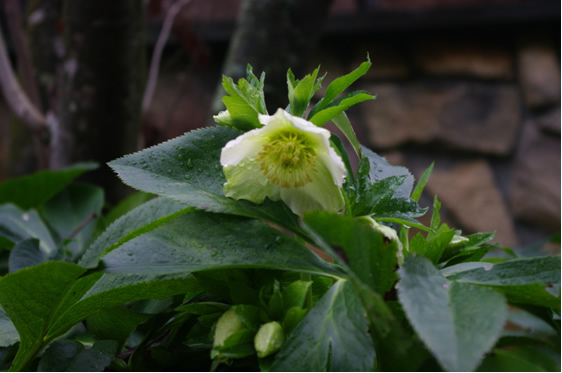
Helleborus niger
Native region: Southern & Central Europe and Southwestern Asia
The so-called “Christmas Rose” began blooming early this year, normally coming into bloom February into March. Now covered by a blanket of snow, the nodding flowers held just slightly above the basal growth of glossy evergreen leaves were a welcome sight, and will be again when the snow melts. H. niger is a little more difficult to grow than its cousin, H. orientalis, or Lenten rose, which is native to parts of Greece, Turkey and Russia. Blooming just a little later, the deep rose colored flower buds of the latter are just beginning to appear in our garden.
Both grow well in organically rich, well-drained soils in part to full shade, with some protection from cold winter winds. Flowers range from creamy white through pink to deep mauve, some with interior spots. When winter’s ravages render the leaves tattered and brown, they can be removed to the ground to show the flowers to their best advantage.
Best in naturalized areas or situated where they can be enjoyed even on winter’s coldest days, Deep Cut’s planting of hellebores is in the Winter Garden, along the path on the south side of the Horticultural Center.
Hellebores are deer resistant and very tolerant of dry shade, lean soil and air pollution, and have no serious insect or disease problems, but one word of caution: The leaves, roots and stems are poisonous to humans.
Amaryllis
Native region: Tropical & Subtropical Regions
Just one of many colorful and interesting flowering and foliage plants to be enjoyed in the display greenhouse through the winter months, amaryllis have become very popular around the holiday season due to their ease of care and the wide selection of colors and forms now available.
With a little care, you can replenish the bulb to bloom again next year. After the blooms have faded, trim the flower stalk to 1-2" above the bulb, leaving the strappy foliage intact. Maintain as a houseplant in a sunny window, watering sparingly and fertilizing about once a month. It can be placed outdoors in summer in partial to full sun. For flowers next winter, induce dormancy in September by withholding water and placing in a cool location (50-55°F). Remove dead leaves. After 8-10 weeks, "wake up" your plant by moving it to a well-lit location about 70°F and keep the soil moist, but not wet. In a few years you may find your bulb has multiplied, producing "baby" bulbs you can pot separately or give away.
Hardy Cyclamen
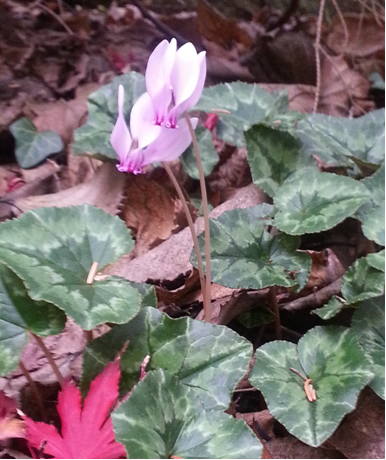
Cyclamen sp.
Native region: Mediterranean
When other plants are going to sleep for the winter, our fall-blooming hardy cyclamen are just waking up. The small but elegant – and sometimes fragrant – flowers are a delight in the fall garden, with their recurved, twisting petals rising above intricately-patterned foliage that will last through winter until spring. This specimen is in the Japanese-inspired garden.
These plants flower during the cool, wet seasons, with the corms lying dormant during the hot, dry summers of their native range. There are over 20 species of cyclamen, the most familiar of which, c. persicum, or “florist’s cyclamen”, is not winter hardy in our region. Many of the rest, blooming either in spring or fall depending on species, are winter hardy in our region. They cross readily, resulting in an amazing variety of rounded to heart-shaped leaves, often with a patterned silver overlay on top and purple on the underside.
Perfect for shady areas of a rockery, border or woodland, they combine well with other shade plants and thrive in dry shade. Place them where you will observe and enjoy their diminutive beauty up close – near walkways, entry, or outdoor seating area. (posted 11/20/2015)
The Monarchs Have Arrived!
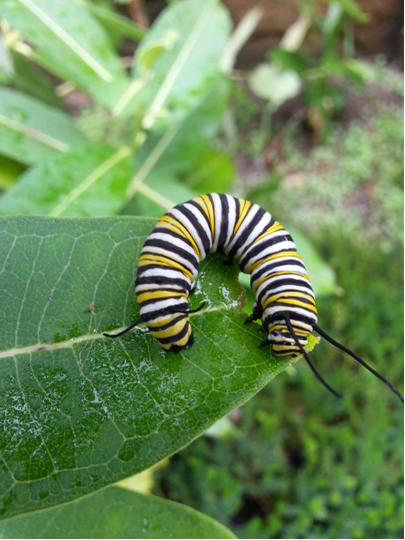
Goodness knows where they’ve been hiding, but we’ve just found six caterpillars in Deep Cut’s Waystation and Rockery. All are now being raised in the protected environment of the vivarium inside the Horticultural Center. One has attached to the top screen, preparing to form its chrysalis, where it will spend the next 10-14 days before finally emerging as a butterfly. Several others look close to the same stage.
It is a perilous life. From egg to adulthood, monarch caterpillars face a number of natural enemies. Hornets, wasps, spiders, ants, and mites may eat the eggs and caterpillars, while tiny tachinid flies and braconid wasps parasitize the caterpillars by laying their eggs on them. A few species of birds, not affected by the glycoside toxins the monarch caterpillars ingest from the milkweed, feed on caterpillars and adults. (posted 8/12/2015)
Bonsai Donation
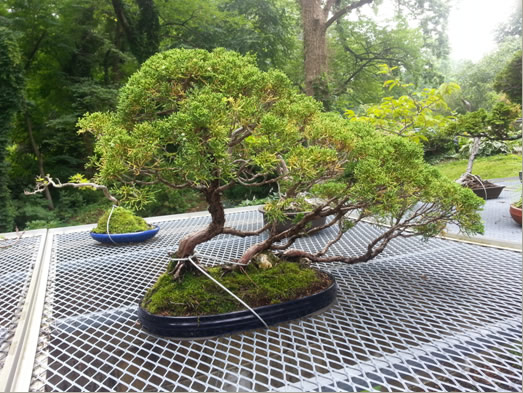
Deep Cut Gardens has received a generous donation of 40 bonsai plants, doubling the collection and adding some very fine examples of the art. Stop by to see the winter hardy specimens on their display/cold-frame and the tropical specimens inside the Display Greenhouse. Mark your calendars for Bonsai Day on Sunday, September 13, 2016, 12 noon until 4:00 p.m., when the Deep Cut Bonsai Club will present demonstrations and displays, sharing their expertise and answering your questions. (posted 7/20/2015)
Monarch Waystation
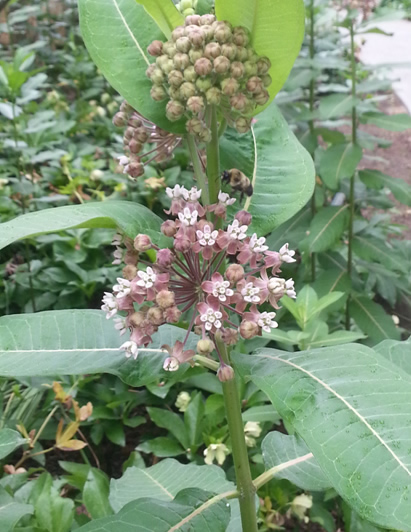
The buffet is open! Deep Cut’s Monarch Waystation and the surrounding gardens provide milkweeds, nectar sources and shelter throughout the season to sustain the monarch butterflies in their breeding and migration. Many other insects are enjoying the spread, but no monarchs, monarch eggs, or monarch caterpillars have been seen yet. This spring, as suggested by professor of entomology Doug Tallamy, we cut back the stems of about half the milkweed plants to approximately 12” to ensure a crop of tender young leaves for the caterpillars. (Posted 6/29/2015)
Eastern Redbud ‘Ruby Falls’

Cercis Canadensis ‘Ruby Falls’
Native region: Eastern United States
Planted just last autumn at Deep Cut Gardens, this is just one of many outstanding cultivars of our native redbud tree. With its weeping habit, early spring flowers, and velvety red-purple leaves, it makes an excellent specimen plant for the home landscape. This highly adaptable small tree will tolerate heat and cold, a range of soil acidity, black walnut, clay soil, and full sun to light shade. About the only condition it cannot abide is a consistently wet soil. Although deer resistant, it provides food for other wildlife. All things considered, an excellent alternative to exotic species. (Posted 6/29/2015)
Ornamental Onion/Allium
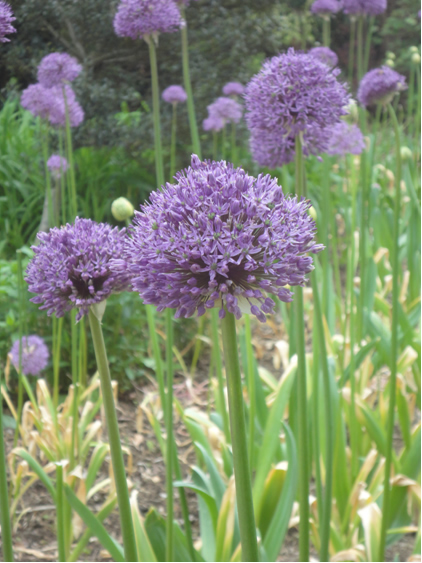
Allium
Native region: Dry, mountainous areas of northern hemisphere
Allium is a genus of about 700 species, which includes chives, garlic, onion and shallots. Many of the ornamental varieties originated in Central Asia and have been cultivated for their ornamental, rather than culinary, qualities. Depending on variety, they range in height from 8 inches to 4 feet, and are available in a wide range of colors. Cold-hardy to USDA Zone 4, these undemanding plants will thrive in any well-drained soil in full sun and are relatively resistant to deer, voles, chipmunks and rabbits. Some have flower heads that dry well for crafts and arrangements.
Plant bulbs in the fall for blooms the following season, and many years thereafter. Plant in groups in groups in a bed or border for best display. (Posted 5/18/2015)
Fairy Ring
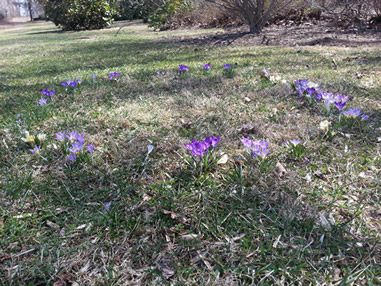
This fairy ring, planted in October 2013, is beginning to bloom in the field by the picnic benches behind the production greenhouse.
(posted 4/6/15)
Witch Hazel
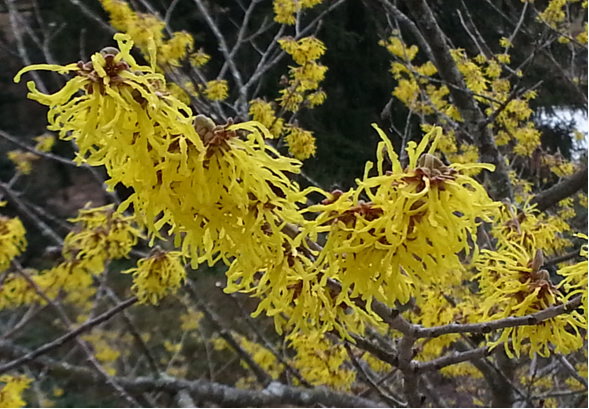
Hamamelis x intermdeia ‘Arnold Promise’
Hamamelis
Native region: Central & Eastern U.S., Mexico, Asia
The witch hazels at Deep Cut are finally in bloom! Depending on species and cultivar, these are among the first and last to lend color to our landscape with their crinkly, strap-like petals in shades from pale to golden yellow, orange, russet and red. The flowers, often fragrant, can last up to a month, even through temperatures in the low 20s. ‘Arnold Promise’ is beside the Horticultural Center, and there are several varieties blooming in the “cut” or ravine south of the display greenhouse. Melting snow has revealed snowdrops and heath already in bloom, as well as flower buds of hellebore (Lenten rose) and daffodils, promising more spring color soon.
Ranging from shrubs to small multi-stemmed trees up to 30’ in height, hamamelis is adaptable to many uses in the home landscape. The Asian varieties bloom January-March, while our native Hamamelis virginiana blooms October-December. All provide nice fall foliage color.
(posted 3/20/15)
Coral Bark Maple
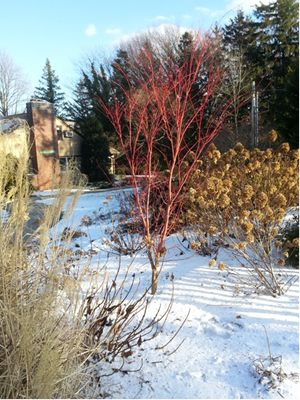
Acer palmatum ‘Sango-kaku’
Native region: Japan
Winter reveals elements overlooked or absent in warmer months. The scarlet limbs of a coral bark maple, the convoluted bole of the dawn redwoods, and the exfoliating bark of the river birches. With deciduous trees bare, the forms, textures and hues of evergreens take on new significance…until spring foliage and flowers return and they once again play a supporting role in the gardens.
(posted 1/21/15)
Koi in Winter
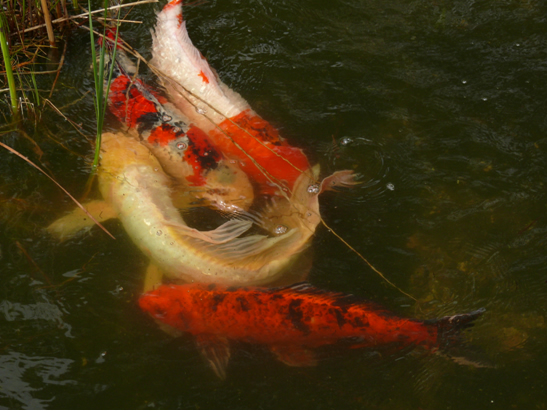
As the gardens’ plants go into dormancy for the winter, so, too, do the beautiful koi in the lily pond. Being cold-blooded, they cannot produce their own heat and their body functions slow drastically, so they are not fed during this time. Except for mild spells during the winter, they will remain at the bottom of the pond where the water temperature is warmest. As spring returns and the water temperature rises to about 50 degrees, they will once again become active near the surface. In the meantime, to ensure that fresh oxygen can enter the water and carbon dioxide can exit, we will be sure that ice does not completely cover the surface. With good living conditions, these hardy and adaptable members of carp family may live 50-70 years.
Posted 11/26/2014
Camellia ‘Winter’s Star’
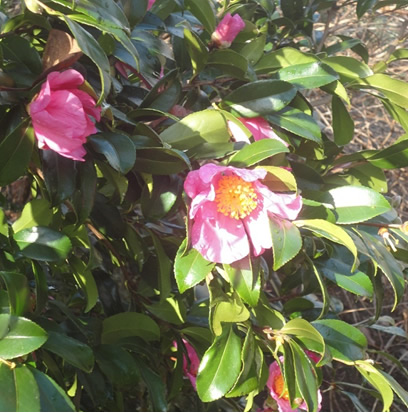
Camellia Oleifera ‘Winter’s Star’
Native region: China
Our camellia is blooming exceptionally early this year. Usually blooming late November into December, this large shrub delights visitors on the front walk with fragrant lavender-pink blossoms for up to six weeks. The glossy dark evergreen foliage is handsome year round.
There are over 200 species in the genus camellia, which is native to eastern and southeastern Asia. All are evergreen, and, being somewhat tender, they are generally winter hardy in USDA Zones 6b-10. Depending on species, bloom time ranges from late summer to spring.
A related plant, C. sinensis is the source of tea leaves. The seeds of C. oliefera and C. sinensis are pressed to produce tea oil, a sweet oil used for cooking and seasoning. This must not be confused with tea tree oil, a camphoraceous oil with antiseptic and antifungal properties, which is taken from melaleuca alternifolia, native to eastern Australia.
Camellias prefer a moist but well-drained, slightly acidic soil (pH of 5.5-6.5) rich in organic matter. They tolerate sun, but will do best situated in dappled shade, sheltered from winds, and given a mulch of 2-3” of leaf mould. As long as their cultural needs are met, they are fairly trouble-free and equally well-suited for the mixed shrub border, woodland garden or as a specimen.
Posted 10/17/2014